WITH BOTHA IN THE FIELD
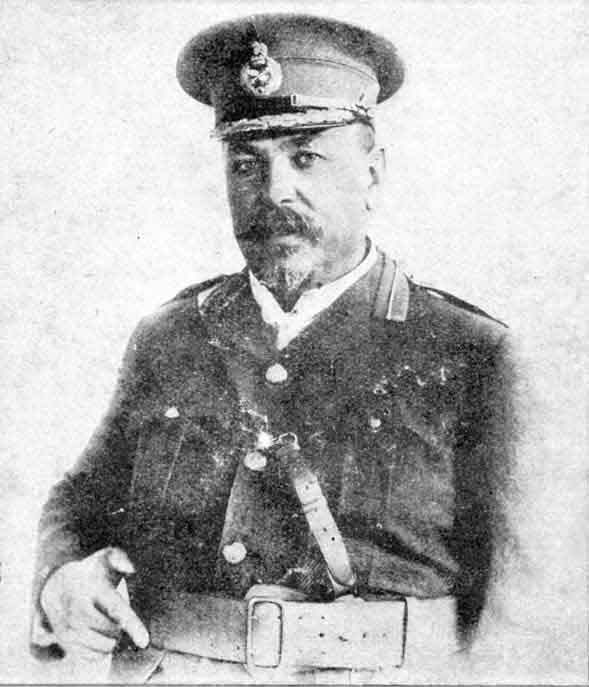
Photo: Leon Lerson, Johannesberg
This eBook is for the use of anyone anywhere at no cost and with almost no restrictions whatsoever. You may copy it, give it away or re-use it under the terms of the Project Gutenberg License included with this eBook or online at www.gutenberg.net
Title: With Botha in the Field
Author: Eric Moore Ritchie
Release Date: May 9, 2005 [eBook #15802]
Language: English
Character set encoding: ISO-8859-1
***START OF THE PROJECT GUTENBERG EBOOK WITH BOTHA IN THE FIELD***
WITH BOTHA IN THE FIELD
Photo: Leon Lerson, Johannesberg BYMOORE RITCHIEWith Five Diagrams and Eighty-two Illustrations mostly by the AuthorLONGMANS, GREEN AND CO.39 PATERNOSTER ROW, LONDONFOURTH AVENUE AND 30TH STREET, NEW YORKBOMBAY, CALCUTTA, AND MADRAS1915 |
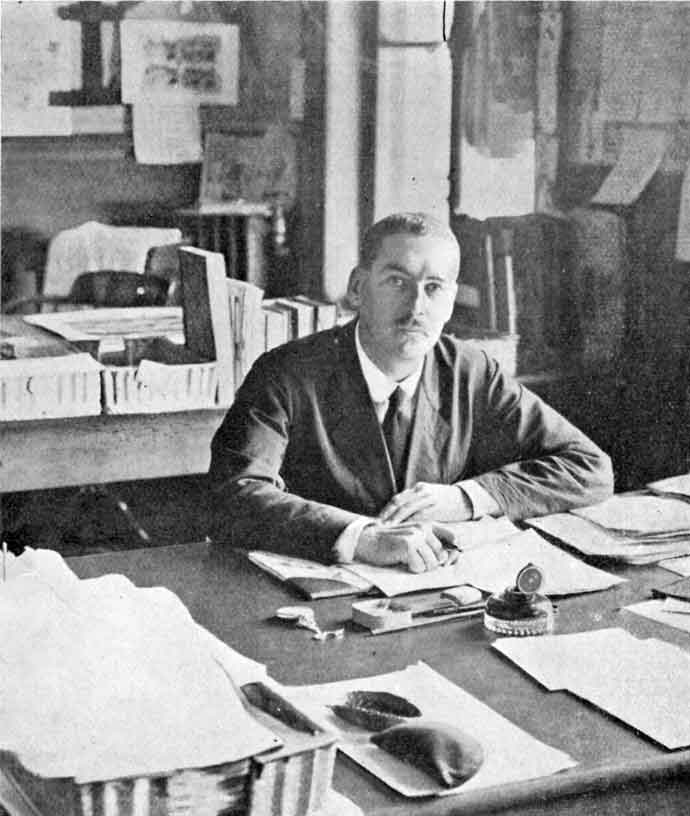
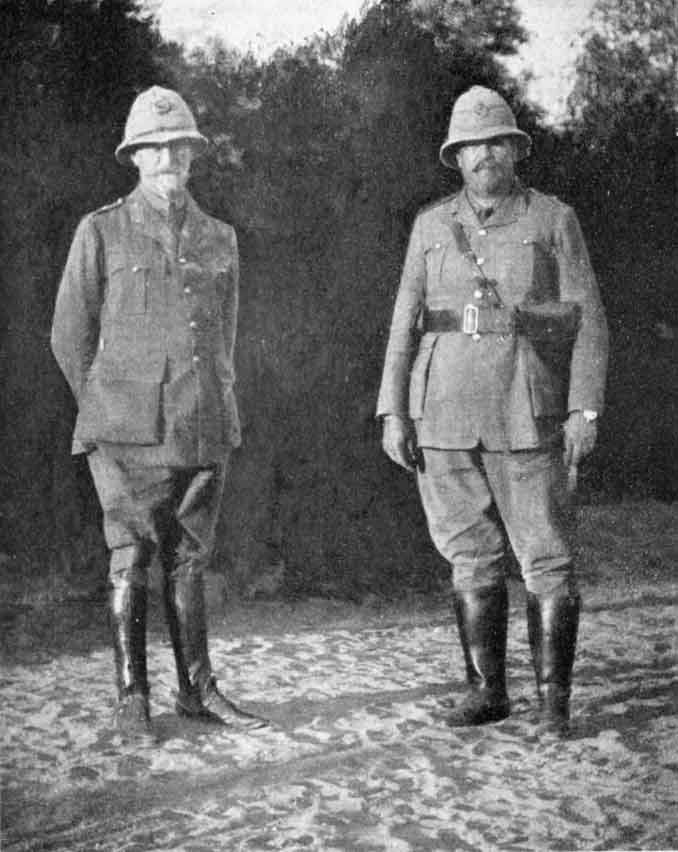
Europe at the present time is lacerated in the greatest war of which man has knowledge. Compared with the doings in the Eastern and Western Fronts, in the Austro-Italian Theatre, or in the Dardanelles, the campaign of South Africa must take a modest place.
My idea is simply to make clear to the public (for example, all names I mention will be easily found on my diagrams, drawn from a German fully detailed map, the best of the South-West African Protectorate in existence) of gentle and patriotic readers something of the latter-day work of a gentleman and a patriot, justly famed amongst peoples with whom integrity and honour are still esteemed sovereign virtues.
"The Nonggai," Pretoria, S. Africa, August1915.
I KEMP AND BEYERS II DE WET III KEMP'S ESCAPE IV FOURIE
I THE PRELIMINARY CANTER II THE FIRST TREK INTO THE NAMIB DESERT III THE RECORD TREK TO WINDHUK IV THE LAST PHASE
General Botha's Bodyguard leaving for the Front
Group of Rebel Leaders [Transcriber's note: missing from original]
Rebels rounded up after the capture of De Wet [Transcriber's note: missing from original]
The last pursuit of Kemp. Flying column crossing the Orange River after him
Troops returning to Pretoria after Nooitgedacht. December 16, 1914
General Botha's train leaves the Orange Free State after the crushing of the Rebellion
Exhausted Troops after defeating De Wet in the Orange Free State
Leaving Pretoria. General Botha's Bodyguard departing
Kits aboard. The Troops departing for the Front
Camp of the Bodyguard at Groote Schuur
Boxing aboard. En route to German South-West Africa
Awaiting landing from the Transport
Trekking over the terrible Sand Dunes near the Coast, German South-West Africa
Some of the first Burghers to land at Walvis
Before the Advance. General Botha photographed with the Red Cross Sisters
Awaiting the Advance. The Commander-in-Chief at tea with the Red Cross Sisters
Awaiting the Advance. Garrison Sports at Swakopmund. Start for 100 yards race
Awaiting the Advance. Garrison Sports. Winner
Swakopmund from the Lighthouse: Extreme Right
Man and Beast in the Desert: both absolutely spent
Looking for Water in the River Bed
A Halt in a River Bed: General Botha has lunch
Main Guard aboard--en route to hunt the Huns
On the Great Trek--the Chief of the Staff has a hair-cut
An unique picture of General Botha, the Commander-in-Chief and his Staff reconnoitring
After Riet water in blessed profusion
A Typical Parade of the Germans in South-West Africa
Typical captured German Infantry
The Great Trek. Otjimbingwe: its Palms and Wells
The Great Trek. Otjimbingwe: the Commander-in-Chief at the old German capital
The Great Trek. Getting Milk from a Goat. Milk was priced beyond Silver
The Great Trek. An extempore bath towards the end of the Trek
A Beauty Spot passed during the last Trek
The Last Phase. Conference at Omaruru. German Staff lunching
The General receives his Bodyguard at a Garden Party after return
German prisoners of war, imprisoned at Karibib
Towards Windhuk. The first troops in Waldau
The first South African Engineer Corps Staff at Windhuk
At Windhuk. How we treat the German women. Ten minutes after occupation
At Windhuk. The Commander-in-Chief addresses his massed troops from the Rathaus
At the Gate of Windhuk. Headquarters Staff Motors awaiting entry
At the Gate of Windhuk. General Botha discusses matters with the Governor of Windhuk
At the Gate of Windhuk. The Interpreter
At the Gate of Windhuk. General Botha emphasises
The great Wireless Station at Windhuk
Conference at Omaruru. General Staff lunching
The Last Phase. The BE2 tuning up in shed before flight over German positions
At the Provost Marshal's office at Windhuk--all in Law and order
The Union Jack just hoisted at the Governor's office, Windhuk
The Great Military Barracks at Windhuk
Windhuk. Basking in the sun: from the great Wireless Station
The Last Phase. Difficulties with General Botha's car through the thick sand
The Last Phase. The Germans had a hobby of blowing up bridges. Here is a fine specimen
Windhuk. The first British station-master and one of his staff
The Fork that Caught the Germans
The Last Phase. Opposite the very spot where surrender was made. A vast ant-hill at 500 Kilometres
South-West Africa. Position of enemy before surrender [Transcriber's note: missing from original]
The Last Phase. The German white flag train just arriving
The Last Phase. General Botha meets Von Franke at 500 Kilometres
The Last Phase. Troops entraining to return home
The Last Phase. The famous Rhodesian Regiment that did so much in the final brilliant movement
The Last Phase. Isumeh. British prisoners released
The German Staff before surrender
Homeward bound! General Botha and Staff returning on the _Ebari_
The Great Man and the Chips of the Old Block returning to the Union after Conquest
"Hello!" I said in surprise. "Why this sudden appearance?"
"This is going to be a big thing, my boy. I am off 'Home.' They will need us all."
It impressed me. He was a person calm and methodical minded, and, like so many good men, he has been dead now many months. His words, which have proved true, were the first to turn my mind definitely to war- thoughts. Besides, the man whose trade is writing has always, when events are stirring, the itch to go, look and note.
In the branch of the Union Service to which I belong--the South African Police--none but Reservists could then proceed to Europe; but when General Botha announced that he himself would take command of the Expeditionary Force to German South-West Africa, a Bodyguard from the South African Police was decided upon, volunteers came forward, and on this unit I had the honour to serve.
The intention of the Union Authorities was to push forward with the German West Campaign as quickly as possible. The Rebellion delayed operations roughly some three months--a period during which some exceedingly severe marchings and stiff rifle actions took place. I mention this deliberately, for in the stir of well-won applause following the victorious end of the Campaign proper, the preliminary canter of the Rebellion is perhaps somewhat forgotten.
It does not seem, in the light of later information, strictly true to say that the Rebellion of 1914 broke upon the Union of South Africa in a manner wholly unexpected. But its ultimate development and extent did cause both surprise and great uneasiness. The details of its various activities over the country are by this time stale history. Leaving comment of a political nature alone, I confine myself briefly to the movements which, performed by General Botha and the loyalist troops, were so swift and accurate in their workings that they broke the back of the main risings before more than local disorganisation and the least possible amount of bloodshed had been achieved.
On the 12th of October the Bodyguard for the German South-West Campaign assembled for field practices, etc., at Pretoria. On the 20th we heard that we should be leaving at an hour's notice, presumably for the South-West. The following day wild and disquieting rumours began to circulate from early morning. Maritz had gone into rebellion. Motor- cars sped all forenoon between General Botha's house close to us and the Union Defence Headquarters. Our camp was full of alarms. The police of Pretoria became suddenly twice as many about the streets. Towards evening it was positively stated that plots were afoot aiming at nothing less than the life of General Botha; and the Main Guard, which had been mounted at the General's house from the day of the Bodyguard's formation, was doubled. Not a soul was allowed within or around the modest grounds of the house without challenge at the point of the bayonet and presentment of the countersign. It will be long before memory loses the picture of those evenings, when through the lighted windows of the left wing of the house the Main Guard first and second reliefs got a view of a familiar ample figure in anxious consultations at a table upon which the electric light cast a mellow glow.
The next day, the 22nd of October, rumour gave way to fact. Rebellion had definitely broken out in the Transvaal and the Free State; Beyers, the ex-Commandant General, Kemp and others were leading in the Transvaal; the names of De Wet and Wessel Wessels were coupled with the Free State. For the second time within a year unhappy South Africa heard rumours of imminent Martial Law proclamations.
Monday morning, the 26th, arrived and found us still waiting; then the Bodyguard got twenty minutes' notice and entrained, horses, kits and everything for Rustenburg. We arrived there at five o'clock the following morning, and started at once in pursuit of rebel commandos which were led by Kemp and Beyers. Before starting, General Botha over a cup of coffee had an anxious consultation with his loyal commandants who had arrived to meet him. Throughout the day we trekked, with one brief halt only, and "outspanned" that night near Oliphant's Nek. During the day the loyal commandos located the rebels without much difficulty; they were routed in all directions, and some eighty were captured. At two o'clock in the morning we continued the trek, stopped in the forenoon on the railway line at Derby (close to Drakfontein, the scene of the British disaster to Benson's Horse during the South African War), and pushing on in the evening to Koster, learnt from incoming scouts that Kemp had escaped capture by minutes only. The direction of his flight was questionable at the time.
Returning to Pretoria, we remained there for a few days. The whole town was in a state of remarkable tension. The police were armed. Armed volunteers were called for. Loyalists were training after working hours in batches on various open spaces. It was freely whispered that the German South-West Campaign would be given up, so formidable was the threatened opposition to it.... I am writing this much less than a year later: and Windhuk has fallen, the Germans have surrendered their territory, and thousands of burghers and volunteers are returning to their homes.
On the 2nd of November we left Pretoria again. More trouble was brewing at Brits, close to Pretoria. We trekked straightway to Zoutpan's Drift, the commandos again pursuing a body of rebels who, cutting through the railway line, had caused damage at De Wilts or Greyling's Post, twenty miles or so outside the Union capital. Quite unwilling to make a stand, the insurgents were again put to flight, and General Botha returned to Pretoria the following day. In the meantime other loyalist columns in the Transvaal had taken to the field, and the rebellion seemed well in hand.
De Wet's delirious harangue had not exhausted its nine-days' life as a masterpiece of unconscious humour when General Botha left Pretoria for the Free State on November 9. Again, I am not concerned with the highly complex motives which prompted the veteran Dutch General to make his delightful "Five Bob Outrage" speech and other things at Vrede. Flogging dead horses is a useless job, anyway.
During the journey to the Free State, our guard en the train was extremely strict. Though every possible precaution of secrecy had been taken, we were positively told to be prepared to find the train fired upon. But, if during such journeys preparedness was doubtless essential in the circumstances, it always seemed to me that we, or any one so placed, were pretty powerless to avert disaster should a properly directed shot from the darkness find its mark.
On November 11 we detrained at Theunissen, in the Free State. It was speedily clear that this part of the world was in the grip of disturbance. Telegraph poles all along the line had been wrecked; an amount of mild pillaging had been going on. The people of Theunissen were almost in panic. The two fights--one against Conroy, at Allaman's Kraal, the other and larger, against De Wet, at Doornberg--had been enormously magnified. General Botha was welcomed in genuine relief. We remained at arms in the train during the first part of the night. At 2 a.m. we were roused, and in less than half an hour were on the way across country to Winburg.
The arrival at the little railhead dorp of Winburg was remarkable. Scarcely were we halted and hand put to loosen girth before the loyalist leaders came running out in the morning sunshine to meet us. De Wet had left the place two hours before, disappearing with his following over the first kopje. He had caused absolute panic. His forces had cut the inhabitants off from all touch with the outer world. De Wet had commandeered all food supplies worth having. Houses had been looted and speeches were made in the marketplace. His followers had assured the people that the Empire was tottering, Germany had defeated Britain on land and sea, a hundred thousand were marching on Pretoria, and that Botha and his Government were defeated and disgraced. And these statements were to a large extent believed.
It was but natural. Cut off the wire and rail communication of a South African veld town and you have isolation in the most thorough sense. In such a place at such a time mere statement may seem quite possibly the truth.
Towards evening we got news of the rebels, and a night-march was ordered. As we left the town the loyal people lined the streets, the fellows in the columns whistled "Tipperary," and we got a rousing farewell.
[Illustration: Group of Rebel Leaders] [missing]
[Illustration: Rebels rounded up after the capture of De Wet] [missing]
General Botha is celebrated amongst fighting men for many things, and his night-marching is one of them. He appears to believe to the fullest extent in night-marching. He had located De Wet at a place called Mushroom Valley, and parts of the Commander-in-Chief's forces had been sent to make a surrounding movement. During the all-night trek from Winburg to Mushroom Valley I had a first thorough experience of the true horrors of sleep-fighting. It was bitterly cold--cold as the Free State night on the veld knows how to be. And we could not smoke, could not talk above a faint murmur, and nodded in our saddles. The clear stars danced fantastically in the sky ahead of us, and the ground seemed to be falling away from us into vast hollows, then rising to our horses' noses ready to smash into us like an impalpable wall. After midnight, outspanning in a piercing wind, we formed square; main guard was posted over the General's car, and those lucky enough to escape turn of duty huddled together under cloaks and dozed fitfully until two-thirty. From two-thirty till sunrise we trekked on. Suddenly, just after good daylight, the Staff halted the column, glasses were put up, and away we swung half right into the veld. Up came the artillery and opened fire on a cluster of ant-sized figures four thousand yards ahead beneath the shoulder of a kopje. Had the thing not contained the very germ of tragedy it would have been laughable to see the way those figures scattered over the red veld. It was De Wet's commandos caught napping. Just before the shell fire our burghers had gone out ahead hell-for-leather on either flank. The whole column then advanced. After two hours' pretty hot work the action was over. We lost six killed against the rebels' twenty-two, and with twenty wounded on our side the rebel losses were proportionate. We took upwards of three hundred prisoners, De Wet himself escaping by the merest fluke. He lost all his transport, and generally ceased after the action to be a serious menace.
During the operations against De Wet I watched, when possible, the demeanour of the quiet South African patriot with whom fate had placed me in the field. I had last seen him many years before, gravely bowing from under a silk hat to a crowd that swayed and cheered as he drove through the streets of Manchester. And now duty found him in the field against an old comrade-in-arms. There was a sadness, there was a profound pathos about it. No wonder if to me it seemed that General Botha looked downcast indeed, if stern as well, during the Rebellion. Life, surely, was not dealing too fairly by him.
Following Mushroom Valley, we trekked, with two brief outspans only, to Clocolan, all the time scattering De Wet's followers. At Clocolan we paused for one day, entrained men and horses and reached Kimberley, via Bloemfontein, on the 18th of November. The following day rebel activities were reported in the direction of Bloemhof; but after an eventless journey we returned to Kimberley on the 21st.
The old town of Upington was transformed in those days. Around the Dutch Reformed Church, standing peaceful and dazzling white in the torrid sun, were tents, wagons, horses, motor-cars, signalling-parties, despatch-riders and infantry. Away over the hard red sand dunes to the north was the action zone, and from that direction every five minutes came sweating motor despatch-riders, who tore along to Headquarters. The following day news came through that the Imperial Light Horse and the Natal Carbineers had been engaging Kemp before and since dawn; almost cornered, he was making a final dash for the border to get into German South-West. It was an anxious time; each minute brought a fresh rumour as to the fighting and the thousands of men Kemp had got together for his desperate move. Our staff returned before dark, reporting an eventless day, with intermittent fighting. On the 28th the Staff went out in motors as far as Rooidam. They returned with bad news in the early afternoon. After a prolonged rearguard action Kemp had succeeded, taking over to the Germans with him a force which was said to be far greater than had been supposed. (Need I add that after events showed there had been gross exaggeration?)
I offer, with reserve, the following ingenious explanation of Kemp's escape; it was told me later by several who saw the action. Near the end of his terrific trek through from the North-Western Transvaal to the German outpost for which he was making, Kemp was hotly pursued by the loyalist troops. His men were exhausted. Half of them were dismounted. All his horses were spent. In these conditions he was forced to the most trying form of fight--the rearguard and flank action. With his goal practically right ahead, he reached three of the parallel large sand dunes with which the veld around Upington is scattered. They were on his left flank. He swerved into them. Hotly pursued, he crossed two, and under the lee of the second left a party of good shots. Then, cantering away over the third, he doubled round on his tracks and with his exhausted followers made for the German outpost. When the Union troops came up they were ambushed at short range, and the check they got just served the fleeing rebel. In the pursuit afterwards our parties found traces of buried rations for horses and men. These had been provided with German thoroughness.
The second phase of the Free State Rebellion was a pantomime more than anything else; a week's pantomime acted in the open veld in rain that never stopped. It was the most miserable week I have known. We left Upington on the 29th of November, reaching Kroonstad, Orange Free State, late next evening. Here the Commander-in-Chief was met by General Smuts, Minister for Defence; a consultation took place, and as a result we left by train for Bethlehem in the evening. Our arrival was timely, too. The place was in a perfect uproar. Nobody knew what was going to happen next. All the loyalistcivilians were under arms. The large mill of the Kaffrarian Steam Flour Company had been converted into a fort which was, in case of necessity, impregnable to rifle-fire. The rebels in the field had declared the New Republic practically established, with temporary capital at Reitz. Just before we saddled up to track them the news came of De Wet's capture on the Malopi River, near Mafeking. The news put everyone in fresher spirits. The charm around the famous guerilla fighter had broken. That the Rebellion was doomed we all knew. But most of us were weary, nevertheless. It furnished a refresher.
We left a happier Bethlehem at a rainy dawn the next day. Half way to Reitz we outspanned in the rain. It rained all night. The following morning came back to mind a talk an old soldier and I had once while freezing one early morning awaiting the Channel boat at Greenock. Alluding to cold and misery, he said: "You don't know what it is, my son, till you've been held up for three nights by rain in war-time in the South African veld, and spent the time standing in water. I did it outside Mafeking." Well, I understand a little now.
The next day our scouts entered Reitz; the rebels had fled. For two days we operated against them. A day later General Botha returned to Reitz. Nothing was said at the time. The fact was that before we entrained at Reitz, on the 7th of December, Wessel Wessels and Serfontein were surrounded. A day later they surrendered: the Orange Free State Rebellion, in all its futility, was over.
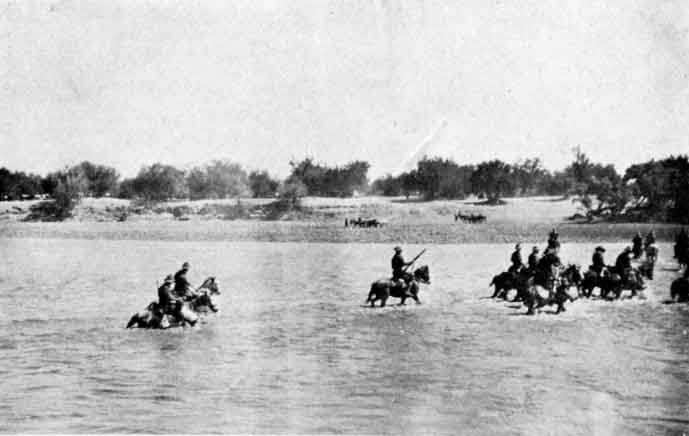
The last pursuit of Kemp. Flying column crossing the Orange River after
him
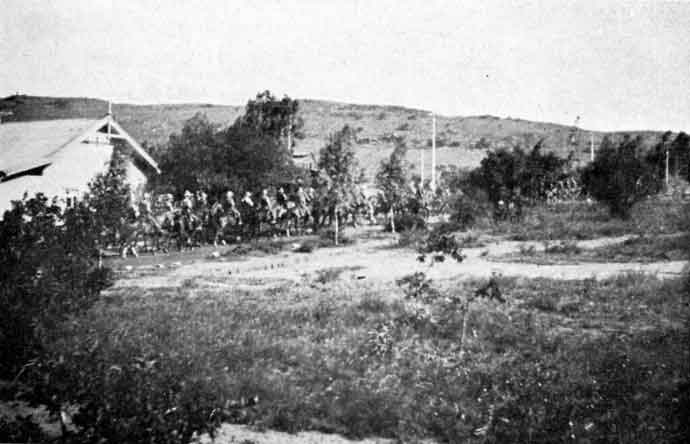
Troops returning to Pretoria after Nooitgedacht. December 16, 1914
Fourie, late Major in the South African Defence Force, possibly the most fanatical of all the rebels, appears to have been a man of character and proved courage. Having got away at the action at Hamanskraal, he and his younger brother were moving about in the veld with ex-Major Pienaar and a moderate force. Their fantastic purpose was said to be the taking of Pretoria itself on Dingaan's Day, the 16th of December. As all the South African world knows, this date marks the anniversary of the famous fight of the Voortrekkers at Blood River in 1838. The day before a force of South African Police, Defence Force, and South African Mounted Riflemen left Pretoria, detrained at Greyling's Post, on the Pietersburg Line, and started in pursuit of the last big rebel commando at large. In this move we of the Bodyguard found ourselves acting; General Botha, who had returned to Pretoria after his severe field work, had gone to his farm for a few days' rest before the South-West campaign.
We trekked at dawn and during the whole of the following day, with one rain-sodden halt, till four in the afternoon. The rebels had doubled in their tracks after reaching a large dam at Blaaubank. Late in the afternoon our scouts returned to the column and reported having located the enemy three miles ahead, entrenched in a donga, or dried-up stony river course, on the farm Nooitgedacht No. 4. We prepared for action, and encountered the rebels in the next half hour. This, the first true action I had been in, was an extremely dirty affair; a man who had gone through some of the worst fights in the South African War afterwards assured me it was the hottest corner he had ever been in. Bush-country fighting is detestable chiefly because you cannot see your enemy until you are on top of him. Our centre cantered in extended order up an avenue flanked by dense bush. We were laughing and asking where the deuce the rebels were, when a hail of rifle fire at short range greeted us. Our fellows were out of their saddles in a second, and advanced to the attack through the bush. Meantime, the South African Police extreme left had swept round to the head of the spruit on both sides of which the donga was formed, the South African Mounted Riflemen and more South African Police closed in, the Defence Force unit getting in rear and in flank of the rebels to cut them off. The attacking party had to work their way through open veld before they could charge the enemy; they made a mark as good as standing game. It was two and a half hours before the "Cease-fire" whistle sounded.
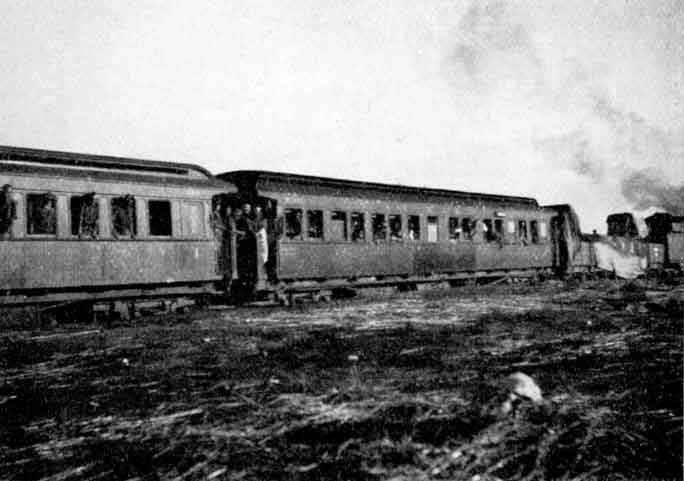
General Botha's train leaves the Orange Free State after the crushing
of the Rebellion
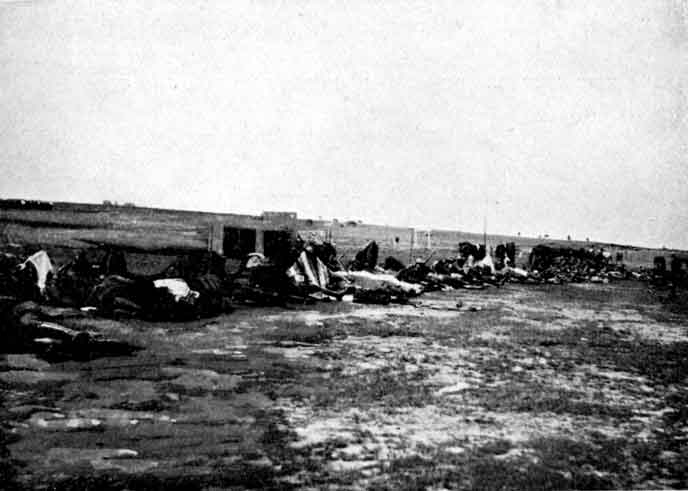
Exhausted Troops after defeating De Wet in the Orange Free State
It fell to me to be a horse-holder (one man in each section is, of course, a horse-holder when mounted infantry are in action) in this fight. In nightmare I have passed that evening since--and wakened quickly, too. The worst of rifle fire is that you can hear bullets whizzing and spitting in trees, but it takes an experienced hand to divine direction. It was only afterwards I found out that a party of rebels were firing on our horses in rear. The horses knew it, though, and shewed it in their eyes. The sun came watery through the clouds just before sunset; I remember during the lulls in the wicked coughs of rifle fire hearing doves cooing gently in the sun-pierced trees.
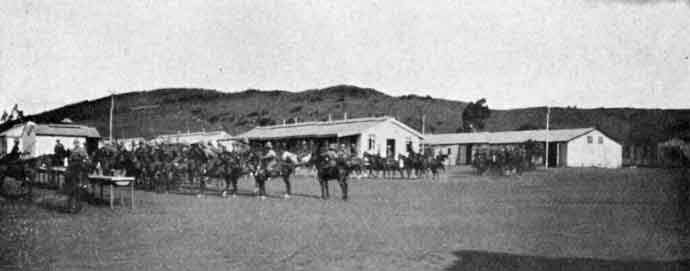
Leaving Pretoria. General Botha's Bodyguard departing
When darkness fell we had captured Fourie, his brother and all his following, except nine men who made their escape at the beginning of the fight. The loyalist casualties in this action were twelve killed and twenty-four wounded. I saw a man who had shared a last cigarette with me as we rode into the action that afternoon lying dead on a blanket three hours later. In that instant I learnt something of the true meaning of war.
There are hundreds of brave deeds that must go unrecognised in these days. But from what I know of this particular action there was an amount of gallantry and quiet heroism displayed amongst the fellows that deserved more than casual comment. I could speak of things I saw, and would like to, moreover. But as for my pains a punched head from outraged modesty would be the reward I shall say no more.
A few days later Fourie was tried by court-martial, convicted, and shot at dawn. In the last days of December the few remaining rebels at large either surrendered or were captured. As the last days of the Old Year slipped by, rebellion within the Union of South Africa died out, and General Botha spent the holidays in peace on his farm at Rusthof--in the haven where he fain would be.
We reached Cape Town on the 15th. I am particular about the date, not entirely as a result of a desire for meticulous accuracy. All who started on the South-West Campaign will remember their Cape Peninsula experience after the heat and burden of the Rebellion. The authorities might have chosen most of our camping grounds about Cape Town with the genial purpose of providing a kind of military holiday as a preliminary canter to the campaign proper. The unit to which I was attached had its temporary resting place on the slopes of Table Mountain at Groote Schuur, on the Rhodes Estate. And I fancy the world has on its vast surface few spots more alluring and more bracing to the spirit.
Up till that time South Africa itself had never put an expeditionary army, to be shipped by sea, on a war footing, and at Cape Town the work of equipping the South-West African Expeditionary Force was carried on and finished during the four weeks we were there. The quiet pine and fir lined roads on the Rondebosch side of Table Mountain complained daily under the traffic of wagons and motors, horses, mules and guns; it ruined the roads and begot unceasing clouds of dust.
And from breakfast-time till late afternoon every street leading to Cape Town and to the great Supply and Ordnance Stores at Maitland and at Portswood Road was filled with grey and khaki carts and wagons roaring steadily along in golden dust. In the whole Peninsula the normal interests of life were for the time being completely side- tracked.
Being associated directly with the Commander-in-Chief and Headquarters, we were fortunate in having our camp on the finest piece of ground on the estate; our tents stretched down a strip of sloping sward, sheltered from the wind by the wonderful trees that luxuriate on the lower falls of Table Mountain; from one's tent entrance the eye was caught by a panorama sweeping a radius of twenty miles inland. I shall never forget those days when in the morning wind and sun I helped to make out requisitions for shirts and breeches and saddlery to the notes of wood music; nor those nights when we lay in our blankets on the grass, stars swinging above, the town-lights winking away below us. It is not often in life that one slips into dreamless slumber on soft grass, lullabied by the night-song of a south-wester in pine trees centuries old.
If we had our discipline and our work at Cape Town, we had our compensations, too. At that time khaki was completely the fashion there. On the long promenade down Adderley Street to the pier-head you could have counted a dozen men in khaki to one in mufti. It reminded one of the days of the South African War fifteen years ago. There was naturally a tendency to make much of the soldier-visitor. It did not spoil him, though. A more orderly lot could not have been found. And this with the people whose guests we were in indulgent mood, and the civic authorities throwing open to us every amusement at their disposal.
Though there was work ahead we were all sorry to leave Cape Town.
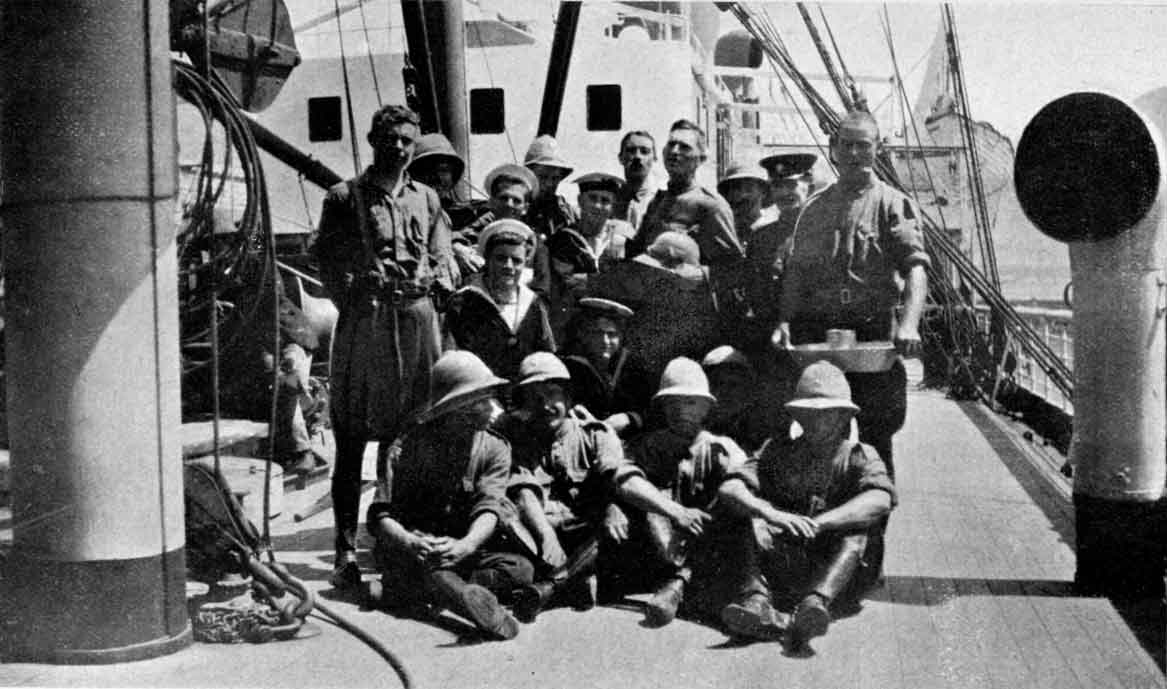
Brothers in Arms. The British Navy and Botha's Bodyguard fraternised
aboard. Many of the latter are, of course, pure South African
On Friday, the 5th of February, we struck camp at sunrise. All our horses had been shipped the day before; we proceeded to the Docks by train and on foot. As showing the kindness with which the troops were treated I must mention that after the heavy work of embarking horses a body of one of the Ladies' War Organisations arranged refreshments for us at the railway station.
The journey by train from Groote Schuur to the City takes about fifteen minutes; by motor about a quarter of that time. But war-work is a trifle different; we were three hours on the heavily laden transport wagons before we got to the transport _Galway Castle_.
Many of us who have moved about a good deal and are fond of the sea were looking forward to that voyage. It was a four days' trip to Walvis Bay; we thought we would have rather a jolly time. Disillusion is hateful. And that trip was disillusionment itself. I suppose we inexperienced ones overlooked automatically the fact that we were in the ranks and travelling to war by transport. It wasn't a high-browed, superior outlook that caused our undoing, I fancy. The thing is, you must rough it soldiering by ship before you grasp the idea. There were other points, too.
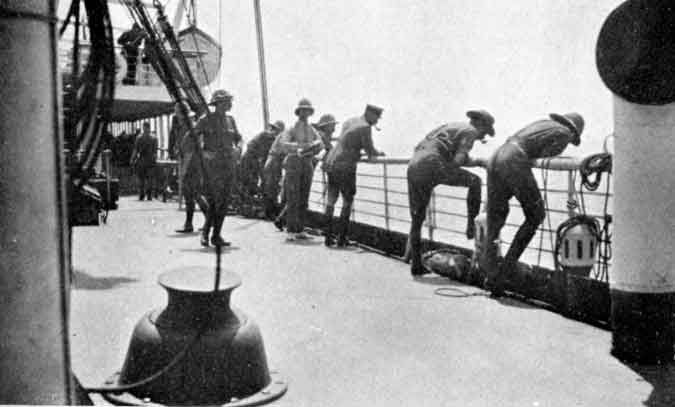
Awaiting landing from the Transport
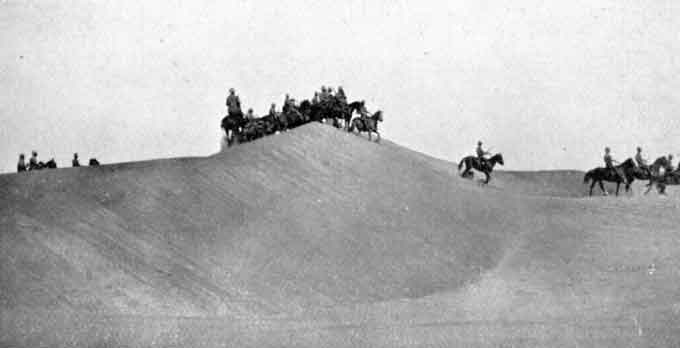
Trekking over the terrible Sand Dunes near the Coast, German South-West
Africa
When we got safely aboard the _Galway Castle_ many of us fancied, in expressive phrase, that we were "well away"; that we had struck a good thing. Our officers were accommodated in befitting state in the first class; our warrants and staff non-commissioned dignitaries were also fixed up in correct style; the rest of us had plenty of room and quietness to ourselves in the third class. All this by 2.30 in the afternoon.
And then eighteen hundred more warriors filed down the quays and, like Mr. Jim Hawkins, came aboard, sir. Now most of these were as good fellows as you could wish for; but they were landsmen, such as never go down to the sea in ships. A large proportion, indeed, had never seen the sea before viewing it at Cape Town. (South Africa is a fair-sized territory.) Very few of them were good sailors. It is not a man's fault that he is not a good sailor; nor is he to blame for knowing little of the ways that make for cleanliness and comfort under even the most trying conditions on shipboard. But on the whole we did not enjoy that four days' voyage to Walvis Bay. It was a case of bedlam as to noise, and "muck in" and take what you can get.
Though my knowledge of organisation for a campaign is not great, I would suggest that for campaign work the only kind of ship used should be a vessel absolutely and completely fitted up as a troopship. If the ships the Government used for the South-West campaign transport had all been fitted up uncompromisingly as "troopers" I fancy we should have fared better.
At 8 a.m. on the 9th we arrived at Walvis Bay. General Botha, who, with his Chief of Staff, A.D.C.'s, etc., had embarked at the Cape on the auxiliary cruiser Armadale Castle, arrived at Walvis later in the morning. We spent the day on board the Galway Castle awaiting orders and the disembarkation of horses.
Since the beginning of the operations in South-West Africa the world has been flooded with descriptions of Walvis Bay; at least I have seen two books with long descriptions of the place, and more than a dozen articles on the subject. I shall not add to this list by any long (and assuredly unconvincing) attempt at a new picture. When you have left the green-covered kopjes of the Cape a few days before and come to anchor in Walvis Bay on a cold morning you think you have reached No- man's-land after a fast voyage. It is a first impression only. The place is desolate enough; it suggests the Sahara run straight into the sea, or the discomforting dreariness of Punta Arenas, in Patagonia.
But first impressions are not everything. Walvis Bay is desolate; a study in yellow ochre sands, burnt sienna duns, tin shanties veiled in hot desert winds, and a sea that seldom knows anything more than a ripple. But that is the point. Walvis Bay is nothing now--but it is a bay. As a fact, it looks to be one of the finest natural harbours in the world. With the South- West interior developing in the future, Walvis Bay should have something to look forward to.
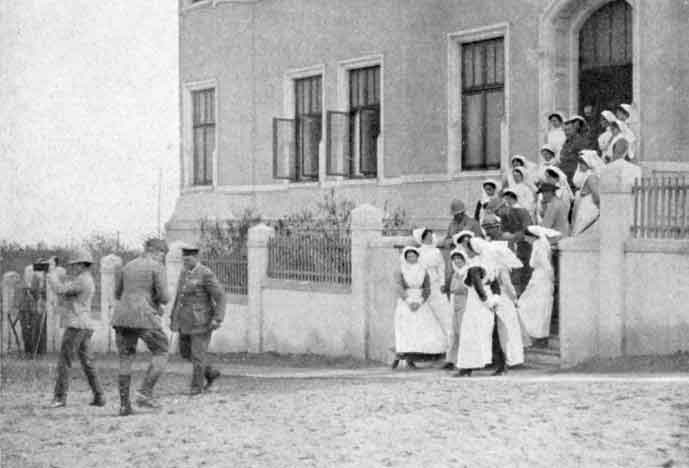
Before the Advance. General Botha photographed with the Red Cross Sisters
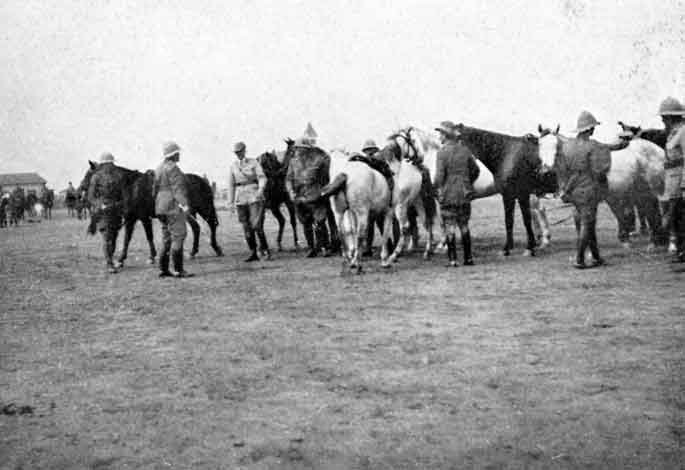
General Botha and Staff alighting for an Inspection.
(The famous Brigadier-General Brits, who trekked to Namutoni, is the
fourth
figure from the right.)
We left the Galway Castle on the 11th, disembarking into lighters, to be towed up the coast to the occupied German port of Swakopmund. Down to the tender, on to the lighter, kits and equipment, and farewell to the quietened steamer. For a while we stood away from her, and rose and fell under no way on the still grey waters. Then we saw a tender from the Armadale Castle steaming towards us. She came up on our starboard quarter and made fast. A figure well known to us all crossed the gangway and climbed to the boat-deck of our steam tender. We had not seen the Commander-in-Chief in personal command since the past bitter days of the Rebellion. A great cheer hit the morning silence and echoed over the bay to each transport at anchor. With a smile of genuine pleasure, General Botha brought his hand to the salute. And away we went, the tender steaming full speed ahead, blunt-nosed barges surging in her wake, for Swakopmund.
Swakopmund was the first Headquarters of the Northern Force, Union Expeditionary Army; we made two sojourns at this German port. First we were there for a period of some five weeks, from February 11 till March 18, whilst awaiting the first advance into the Namib Desert; then we were there for a further month, from the 27th of March till the 25th of April, whilst awaiting the general advance to Windhuk and Karibib.
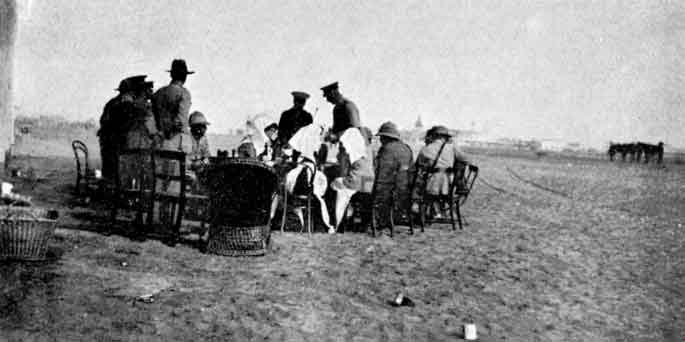
Awaiting the Advance. The Commander-in-Chief at tea with the Red Cross
Sisters
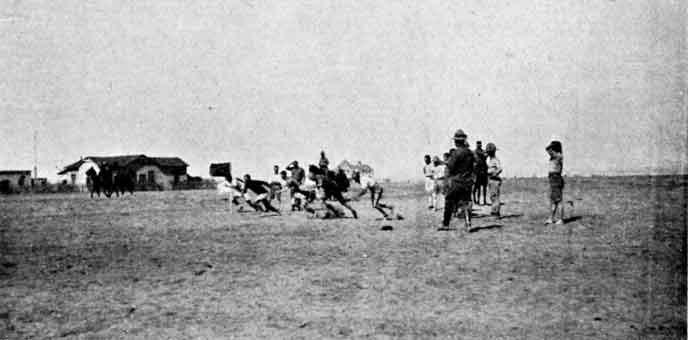
Awaiting the Advance. Garrison Sports at Swakopmund. Start for 100
yards race
It is difficult to write about Swakopmund. As a town it is the most extraordinary place I have seen. I use the superlative deliberately. But I do not wish to live there. It is purely artificial, and artificial to a ghastly degree too. There is not a spot of vegetation. There is not a genuine tree to be seen. The water has a detestable, unsatisfying blurred taste, to which the adjective "brackish" is applied. It is probable that a town occupied by enemy troops does not look at its best; but the fact that it was under such conditions when I first knew Swakopmund makes no important difference. The place in its essentials must always be the same. If ever there was a work of bluff Swakopmund is that thing. One fancies the German commercial expert, a Government official, or, maybe, a representative of the ubiquitous Woermann, Brock & Co., looking along this ferocious and awful coast for a spot to found a town that should appear on the maps and be esteemed a seaport. The Swakop River? Very well. Was there water there? But certainly so; water obviously of the worst quality--yet water. Besides, were there not always refrigerators and condensing machinery? Upon which Swakopmund was forced into existence--planked down there bit by bit in the face of circumstance. Walk a trifle over a thousand yards from the edge of the changeful Atlantic through Swakopmund's deep sandy streets and you get the key to the town. For it ceases utterly, abruptly; from the door of its last villa, fitted with perfect furnishings from Hamburg, the bitter desolation that is the Namib Desert stretches away from your, very feet. Marvelling at this place, I was particularly struck by the size of its cemetery. But I was not long puzzled. If you strike Swakopmund on a fine sunshiny day you will be pretty favourably impressed with the climate; it seems warm and temperate, and the sun sparkles on the sea.
In a week or so you will learn to modify that judgment. More than half the days we were at Swakopmund a heavy pall of dampness hung over the place, and after a day or two of it one's system seemed to be badly affected. Maybe we were not acclimatised, but the fact remains that a very large proportion of us were down with a kind of dysentery, attended by vomiting and violent pains in the stomach. Then there are days when the winds blow from the desert--an indescribable experience. They bring moths and flies with them, and great clouds of sand; it is a genuine labour to breathe, and at noon and for two hours after the temperature in the sun runs up into the "hundred-and-sixties." Swakopmund is not a health resort; or perhaps we dwelt there in the wrong season, But it is a monument to Teutonic determination. The Germans willed this town there, planted it on the edge of the wilderness; fitted it out, from bioscope theatre to church with organ and electric organola; and they lived in it, with the climate of perdition and all the accessories of a suburb of Berlin, and called it a seaport. It is not a seaport; in a fair gale you can't land a barrel of corks at the pier. But given time and they would have built in the face of nature a two million pounds breakwater and everything complete. Yes, they are a thorough people; they are human ants as regards work. Nevertheless, it is not colonising. The Germans are not colonists.
Army Headquarters were fixed at the Damaraland Building close to the shore--a splendidly equipped edifice, with a tower commanding a fifteen-mile-radius view of the desert and the sea. General Botha made the private quarters of the General Officer Commanding-in-Chief at the Woermann Line House close by.
When we arrived at the northern seaport it had been in our possession many weeks, but our troops were occupying the trenches just outside the town, and from the Damaralands Building Tower our look-out and signallers could see through the heat-haze the enemy's patrols moving to and fro in the glistening sands beyond.
Whilst awaiting orders for an advance, life at Swakopmund was in some ways quite good. There were two attractions: regimental concerts, when sanctioned, and the shore. South Africa at war differs in great degree from other parts of the world. The country has the germ in its blood. Men who have campaigned before felt the stirring in them when the South-West campaign started. The call for volunteers acted like a magnet. All sorts and conditions of men were found with the Forces in the South-West. Patriotism called them; but there called them also that deep-seated spirit of unrest which prompts so powerfully when war drums sound once again. I used to think Kipling exaggerated a trifle; now I know the truth. At the concerts on the South-West front the most astonishing array of talent was to be found. One such function in particular stands out in mind. The stage was made up of army biscuit boxes supporting rough planking outside a builder's yard in the deep sand. At a borrowed piano belonging to some vanished resident a trooper officiated; he was clothed in a grey back shirt and ammunition boots-- and displayed the daedal methods of a Fragson. Singers of every type with every kind of voice, and perfectly trained, performed. Only later did I learn that amongst the artists were half a dozen of the best performers in Johannesburg. And at the foreshore, between fatigues, drills, and spells of duty the fellows used to gather, to enjoy the one luxury of Swakopmund--the surf-bathing. Here you would meet men upon whom you never expected again to set eyes assembled literally from all over South Africa from the Cape to the Zambesi. Belonging to one regiment I met, in privates and corporals, six well-to-do farmers, a handful of solicitors, bank clerks, a sub-native commissioner or two, and the no longer youthful private secretary to one of the most eminent semi-public companies in Africa. And there we all were cut off from the outside world. Each evening we got an issue of the official Bulletin-- six square inches of paper thankfully received. For the rest we had no change from the perpetual sound of the sea and the mournful note of the bell-buoy that marks the inshore shoal. Its "dong-dong, dong-dong-dong" created a perfect illusion of the call to a tiny church through the country lanes of England. Everyone who was there can still hear the old bell-buoy at Swakopmund.
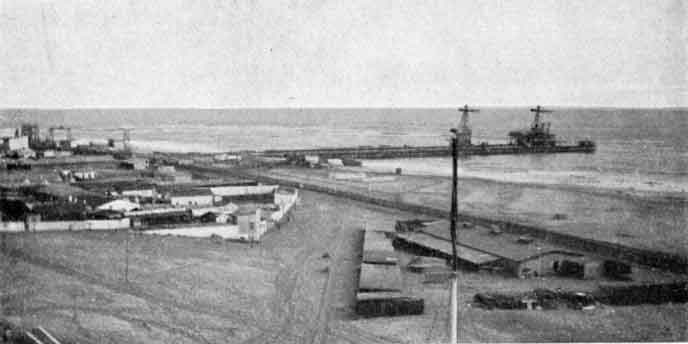
Swakopmund from the Lighthouse: Extreme Right
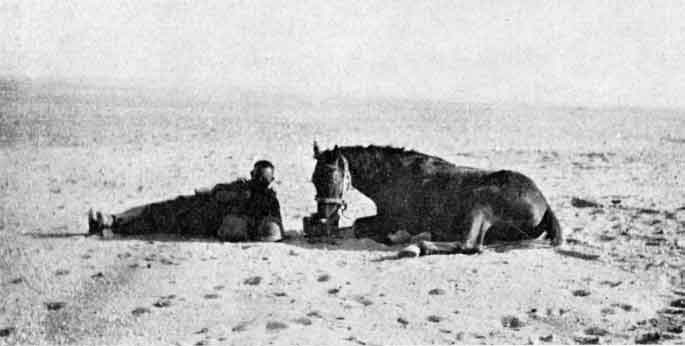
Man and Beast in the Desert: both absolutely spent
Following the operations on the 23rd of February, the mounted troops pushed steadily into the desert, occupying with merely nominal resistance Goanikontes, the water-hole and police post at Haigamkhab, and the water-hole at Husab.
On the 18th of March the Commander-in-Chief and Staff, with all forces except those detailed to the base and infantry already holding the line and stores depots, etc., trekked out from Swakopmund on what was officially described as a "reconnaissance." It was really the first big push into the Namib Desert. The enemy had taken up an extremely strong position on the edge of the desert proper, on the front indicated on the general diagram of the campaign marked Pforte-Jakalswater-Riet.
I have little official knowledge on the tactics of the campaign; it is necessary, however, here to allude to the plan of proceeding known to every one who took any part in it. The vital consideration to the advance of any army across the Namib Desert is to secure the water- holes on the Swakop River. The Swakop is by no means the usual prepossessing kind of stream that flows efficiently between wide banks. It flowed actually for a day just after General Botha landed at Swakopmund-- the first and last time, apparently, within the memory of man. But it has water in it nevertheless; and at fixed and charted spots are to be found bore-holes and wells for the convenience of dwellers in the profitless wilderness. The principal wells and holes are at the places marked on the diagram. General Botha's principal task was to take an army right across the Namib Desert, and to do that he had to capture every water-hole and keep it. It is true that at certain points in the Swakop and other of the large rivers of South-West Africa you can find water by digging very near the surface--perhaps. But when you have a parched army at your back you must deal as little as possible in speculation. At Riet and Jakalswater the enemy had determined to hold the valuable water-holes at any cost, but especially at Riet.
When General Botha treks he treks at express speed. With him the intention is that the essence of strategy shall be surprise. The Commander-in-Chief left Swakopmund at 2.30 a.m. on the 18th of March. We outspanned at Goanikontes, thirty-four kilos, at 10.30 that night. Goanikontes was left at 6.30 a.m., and the Husab Outspan was made at 10.20 that morning. The rest of the day was spent at Husab; at 6.30 in the evening the Commander-in-Chief, and with him General Brits, left for Riet, outspanned for a few hours and attacked the German position at Riet at dawn on the 20th. The general action which was fought on the Pforte-Jakalswater-Riet front on this day was conceivably the most important move of the campaign. It was essential that the water-holes should be secured.
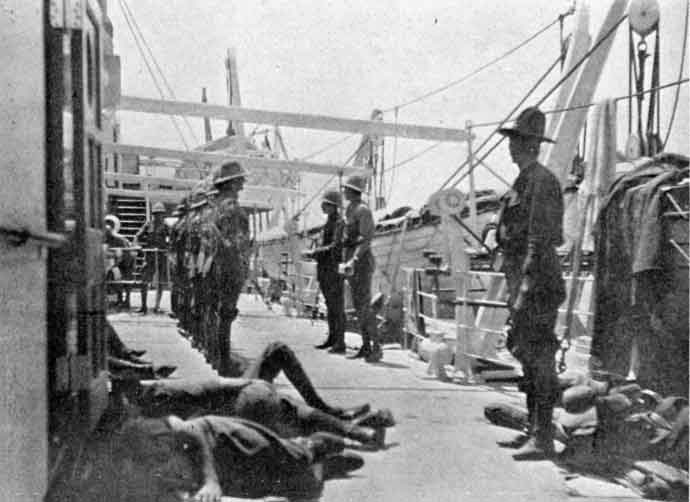
Main Guard aboard--en route to hunt the Huns
Around Riet, the principal point of attack and defence, the disposition of the Germans was as strong as it is possible to imagine. My sketch of the place should give a fair idea of things. In the technical sense it is not a true plan; but accuracy is not sacrificed to clearness. The veld around the Riet water-holes is just a mass of small kopjes and rocks; it narrows to a small defile that opens suddenly on to the coverless Husab Road. This defile is the only main approach to the Riet wells, and it is commanded close up on both flanks--on the right by the great bare kopje, Langer Heinreich, on the other by small kopjes and a line of ridges.
In attacking this position General Botha had to consider not only the enemy's strength of position, but also the fact that his troops had to go into action after a waterless twenty-odd mile trek over the desert. As the Commander-in-Chief got up to his front on the 20th the big guns had started. The artillery duel continued well into the afternoon. Every credit is due to the other units, but it was our artillery that cracked the nut at Riet. The range was 2,700 yards; but the Germans never got it. Why it is difficult to say; they had every advantage, and one understands that the Germans are nothing if not artillerists. But they were a wash-out at Riet; they were over-firing the whole time. On the other hand, the Union gunners got the range at once and were all over the enemy. They put an ammunition wagon out of action after three shots, and did further deadly work. That afternoon General Botha sent a detachment out to attempt an enveloping movement. But they came back later, reporting that the slopes of Langer Heinreich on the right and the sharp kopjes on the left made the thing impossible.
As the afternoon came on I may say I don't think we knew too much about the state of affairs with the enemy, and when he ceased artillery fire about 3.30 p.m. everyone seemed pleased enough. Few knew then that the German Commander had begun to evacuate the position; his supply of shells was said to have run short. On account of our numbers, also, he feared an enfilading movement on his left flank should our mounted infantry advance to the defile Q.
In the meantime the authorities had decided we must find water in the rear; for that purpose a party was at once despatched to Gawieb, in the Swakop River bed. It was found by a party from the Commander-in-Chief's Bodyguard, and at the Gawieb Hole the greater part of the forces watered that night. And they took seven hours to do it.
Before sundown General Botha, with Staff and Bodyguard, fell back two miles on the Husab-Riet Road and camped there for the night. Scarcely had the Headquarters party arrived before news came that the enemy was in precipitate flight, had evacuated Riet and had blown up his small ammunition and railway water-tanks at the Riet terminus of the narrow gauge railway line to Jakalswater. Bodies of the Union troops had occupied Riet on the evening of the 20th.
The actions at the Jakalswater and Pforte fronts, to fight which the columns had swept away to our left the night before, were equally successful.
That is the general story of the fight of the 20th March on the inland edge of the Namib Desert. But how to picture vividly the scene before Riet that day? At dawn in those parts conditions are bearable enough; the sun has little strength; the night wind refreshes. From 6.30 till 10 o'clock the desert is endurable. Then comes the change. All along the front the stark yellow sand is taking on a different hue under the climbing sun rays. It turns almost to glaring whiteness all around-- to where it stops short at the foot of those scorched and smothered rocks on the left flank. To our right the members of the Headquarters Staff are standing--sitting--resting. An officer brings his glasses down slowly, blinks, feels for a pipe, lights it. Another moves head and extended arm to the right and makes a remark to a colleague. Along the ridge we occupy the Bodyguard are standing-to and watching the action; you see that fellow wearily ease a heavy bandolier; further down another brings an army biscuit from his haversack and breaks it on his boot.
And now look at that little group almost straight ahead of us; as the tall Chief-of-Staff moves aside you see a figure on a little camp stool. The left hand is just under the hip, binoculars are in the right; up go both hands with the glasses; down they come. He speaks to the Chief-of-Staff; there is the favourite gesture--the arm is jerked out horizontally, the hand pointing loosely, and dropped again. The face is powdered with fine sand and dust; during the day he has been allowed a small beaker of water from the artillery. A favour indeed. That is Botha--Louis Botha, Commander-in-Chief, the man who leads us. And on either flank, well screened, little knots of men are grouped round the guns--and "Hampang-ky-yao!" they go in our ears, their report carrying ten miles back into the desert where our transport hears them in muffled thunder. And look up as you hear that screeching whistle. The enemy's shells burst in the depression behind us on both flanks-- "Pa-ha-ha." They look like slabs of cotton wool against the brazen blue sky. And all afternoon the heat strikes up at you overpowering, like the breath of a wild animal. Then the wind rises, and the sand shifts in eddies. Veils and goggles are useless. They can't keep out that spinning curtain of grit. The horses rattle the hard, dry bits in their mouths, trying to get some moisture.
On the 21st Headquarters moved into Riet. Here we found two water-holes in the bed of the river; one was a splendid Persian well, with chain buckets. Riet was no paradise; it was a luxury though, even if the river sand was blinding, to lie under a wagon and hear the water running.
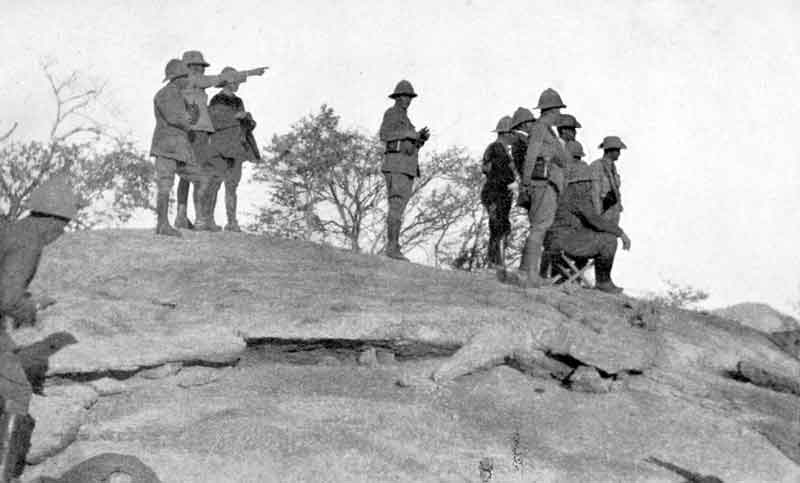
An unique picture of General Botha, the Commander-in-Chief and his
Staff reconnoitring
Our casualties in the actions on the Pforte-Jakalswater-Riet front were fifteen killed, thirty- nine wounded and forty-two missing. On the 21st our commandos occupied Salem, eight miles further up the Swakop River.
The Commander-in-Chief and his party remained at Riet till the 24th. It was then decided that a supply depot must be established at Riet before further advance was made. On the evening of the 24th Headquarters returned to Swakopmund, reaching the coast at 9.30 on the morning of the 26th--an extremely fast trek.
Looking out of my window in the heart of civilisation at the evening sun that glorifies the Pretoria green kopjes, the scene dissolves. In its place comes the picture of the first gaunt daylight on the 26th of March last at fifteen kilometres, just going into Swakopmund. The mist from the coast had rolled inland; through it after dawn came miles of horsemen and wagons, guns, limbers, lorries, ambulances. Every human unit in that column was covered in white dust, and every horse was weary. And except for the staccato "click-click" of bits and an occasional deep hum from a passing motor the army moved in perfect silence through the sand.
The official history of the South-West campaign remains to be written, of course; in the meantime I am convinced that the actions on the twenty-one mile Pforte-Jakalswater-Riet front were practically the deciding factors of the campaign.
The whole plan of campaign was very much this. The Protectorate was to be invaded from several angles, the route of these various forces being quite clear, I hope, in the diagram given. Roughly speaking there were three forces: the Northern (General Botha, Commander-in-Chief), working inland from Swakopmund; the Central (Brigadier-General Mackenzie) working inland from Luderitzbucht; and the Southern and South-Eastern converging on Keetmanshoop from Raman's Drift-Warmbad-Kalkfontein (Hartigan's Horse), from Upington (Brigadier-General van Deventer and Colonel Celliers) and from Kimberley-Hasuur (Colonel Berrange's column). As a result of this great concentration on Keetmanshoop and northwards from all sides, the Germans would be forced to decisive action, to retreat northwards, or be cut off. Upon these forces reaching a certain distance inland a general move would be made in the direction of Windhuk--and again the enemy would have to fight or retreat to the limits of his railway system.
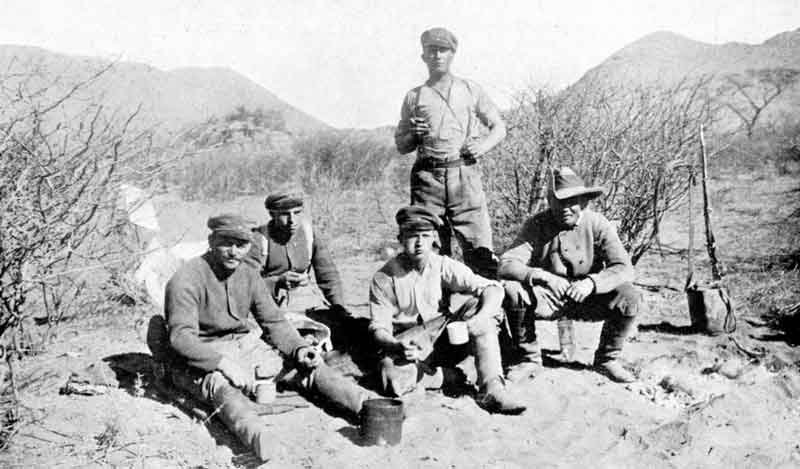
Typical captured German Infantry
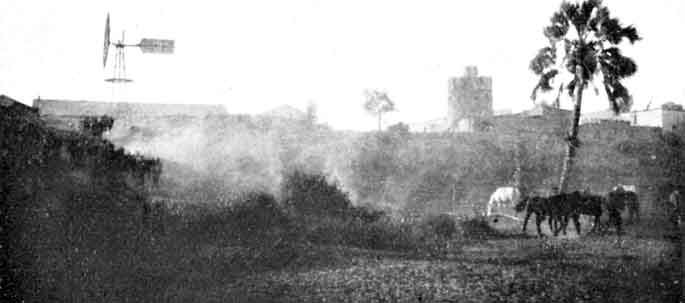
The Great Trek. Otjimbingwe: its Palms and Wells
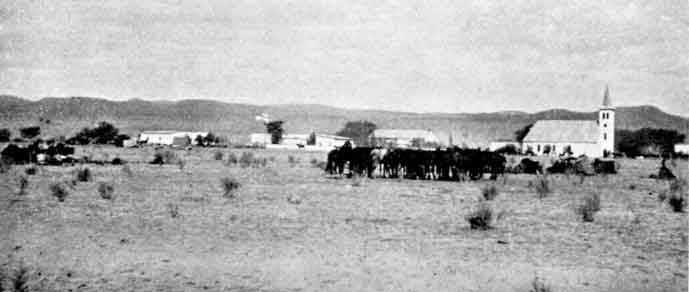
The Great Trek. Otjimbingwe: the Commander-in-Chief at the old German
capital
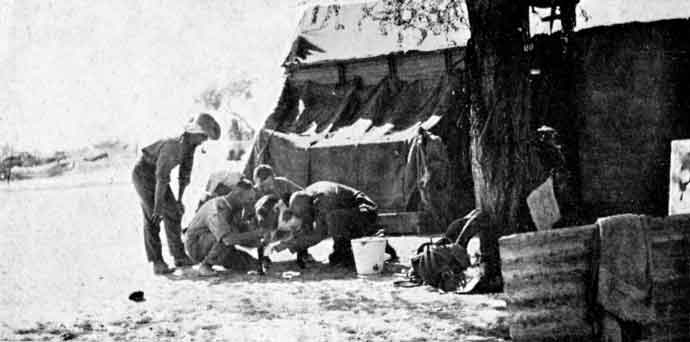
The Great Trek. Getting Milk from a Goat. Milk was priced beyond Silver
On the 30th of March the Commander-in-Chief returned to Swakopmund, and the same day news came of the occupation of Aus by the Central Force. It was now that we heard definitely that General Smuts was in the field with the forces south of us.
With the Central and Southern advances, General Mackenzie, from Luderitzbucht, occupied Garub on the 22nd of February, and Aus on March 31. Colonel Berrange's column, having left Hasuur on the 3rd of March, reached Kabus, by Keetmanshoop, on the 19th. Leaving Raman's Drift on the 2nd of April, Colonel Hartigan's column occupied Kalkfontein on the 14th of April, and reached Keetmanshoop on the 20th of April. Seeheim was occupied on the 18th of April. The advance to these towns was achieved by a series of fast treks in which frightful conditions of thirst and fatigue were encountered. General Mackenzie's troops in their advance north occupied Bethany on the 13th of April, and continued northward to Berseba, Gibeon, etc., on the way to Windhuk.
We now come to the feat that broke all known marching records and caused two hemispheres to talk. On Sunday and Monday, the 25th and 26th of April, General Botha's forces left the coast: on the 5th of May they were outside Windhuk. Striking right across the desert through every kind of country, General Botha's army marched night and day, and in five of those days covered a minimum distance of a hundred and ninety miles. Many units did much more than two hundred miles-- over forty miles per day.
It was some trekking.
Swakopmund was left on the 26th of April at dawn. Haigkamchab was reached by I on the same afternoon, and Husab supply base at 6.30 p.m. Next day Husab was left at 2.15 p.m.; the column halted for a few minutes at 5 p.m., and pushed right through to Riet, which was made at 10.20 that evening. Headquarters rested all day on the 28th at Riet, left it at 8 p.m., trekked by moonlight along the Swakop River for three hours, outspanned till an hour before dawn, and made Salem at 6.45 a.m. on March 29. At 9.30 that morning the column moved on again, reached outspan at twenty miles by 1.35 in the afternoon, rested for an hour and a half and pushed on again till a quarter before midnight, when it rode into Wilhelmsfeste. But the water was at Kaltenhausen, some miles further ahead of this military post. We reached it at 1.15 on the morning of the 30th. Animals took two hours to water in the bitterly cold morning air. The guards had not taken two steps on their beat before the sand was littered with sleepers that looked like dead men. These sleeping columns, some ninety to a hundred miles from the coast, were now half way to Windhuk.
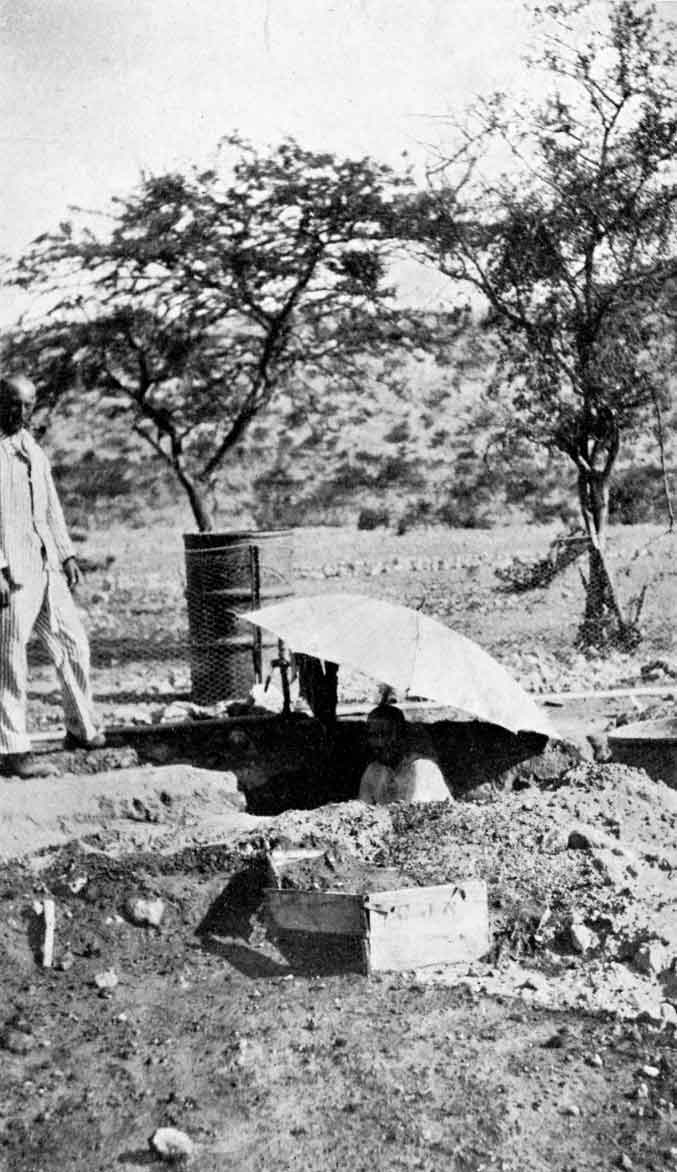
The Great Trek. An extempore bath towards the end of the Trek
Two hours after daylight General Headquarters moved to a camping ground two miles back towards Wilhelmsfeste (Tsaobis), and rested during the day in the shade of the scant trees with which the veld was covered as the desert was left behind. The rest of the Northern Army had trekked on with scarcely any pause. Shortly before sunset, the Commander-in- Chief set out on a night march of twenty odd miles to Otjimbingwe. The trek was done at a fierce pace till midnight, when an outspan was ordered; the party slept for four hours, and made Otjimbingwe just as the dawn of the 1st of May was breaking. As General Botha rode into this old mission settlement the rear of the German forces, closely pursued, was galloping in retreat over the kopjes to the east. Many prisoners were taken here. General Botha spent the day at Otjimbingwe, left at dawn on the 2nd, and trekked north-west seventeen miles to Pot Mine, which he reached at 12.45 p.m. Here the Commander-in-Chief awaited the arrival of General Smuts, had a conference with him, and moved in force on Karibib at 2 a.m. on the 5th of May. He trekked the whole of that day, with two halts of an hour each, and entered Karibib on the heels of the enemy at five o'clock in the afternoon. At the same time the rest of the Northern Force had entered Okasise, Okahandja, Waldau, and other stations on the railway, had captured the whole system practically up to Omaruru, and were at the gates of Windhuk. The German forces were in full retreat to the north and north-east. Their civilian populations, left behind in the towns, seemed dumfoundered at the appearance of the Union troops. Meantime the Southern and Central Armies had approached the German capital on the southern flank.
This account of the advance through the desert of General Botha's Northern Force is purposely bald. The process of a vast flooding of water over a country is in essence bald and direct. And that is as near as I can get for comparison. General Botha's advance was like a well- ordered flood: which, I take it, was exactly the idea. At a fixed time organised bodies of men, mounted, dismounted and with artillery, were systematically poured over the German territory. I am sure most of the fellows who took part in that advance and recall it in detail will in the future look back and wonder. For it is a subject for wonder, even if history does contain some marches more eventful. It has been stated since that all transport was left behind. But that is not strictly true: a large quantity of transport was brought on by the Union Forces; passed through the deepest sand in waterless desert, between gorges, over big kopjes, into almost trackless bushveld--and was never more than a day and a half behind. At one place out of a convoy of twenty- seven wagons, seventeen capsized.
It is hackneyed, I know, but there is only one way to describe the great trek to Windhuk. It was absolutely "a chequer-board of nights and days." Looking at my diary just now, that I have had ten years' practice at keeping, I see a confusion got into the dates. You didn't know anything about the date or the day of the week. Existence was just a dateless alternation of light and darkness, of saddle-up and off- saddle, of cossack-post, of thinking about water--and of yearning with every fibre of one's being for the ineffable boon of a long sleep.
It will be seen that the key to the advance over the Namib Desert was the Swakop River. The water-holes of the Swakop River are very singular; they form the nucleus of a kind of settlement (even if it be only a couple of small huts) right in the dry river bed. At Kaltenhausen, to take but one example, there is a splendid shooting- lodge slapbang in the centre of the river; it has a fine courtyard walled and railed in. It seemed extraordinary. At these water-holes you suddenly leave the stony sand of the desert and come on to finest soft sand. It is quite pleasant at night, but day tells another story. Just after sunrise a wind starts blowing down the river valley and raises this superfine, mineralised sand. To lie exposed to this for a day is an awful experience; the fine dust will penetrate anywhere. I am sure it must lead to positive blindness in time.
I mentioned the water-holes of the Swakop River for the particular reason that their situation in most cases adds immensely to the merit of the Northern Army's great trek. The trek-road from Swakopmund follows the river only in a broad sense; the Haigamkhab, Husab and Gawieb water-holes are really three to four and five miles from the road and the camping grounds. That is to say, the columns, after a twenty mile trek in the sand and sun had another quarter of the distance to go--_to water_. And to water usually means across the yard to the troughs, so to speak. We shall remember the water-holes of South-West Africa. There is many a fellow now back in civilisation who can recall vividly the tramp over stony, loose gravel through those great echoing rocks down to the water-holes at Haigamkhab, Husab and Gawieb. Hour after hour the processions of weary riders passed each other in a cloud of dust that rose five hundred yards and filled the choking canyon. The invariable question from him going wearily to water to him coming refreshed and smothered in water-bottles and with a livelier horse from it: "Is it far, boy?" And the stereotyped answer of encouragement was as always: "No, no; just round the corner." All these water-holes are almost duplicates of each other. I suppose not the echo of a bird now hurts their pristine and awful quietude.
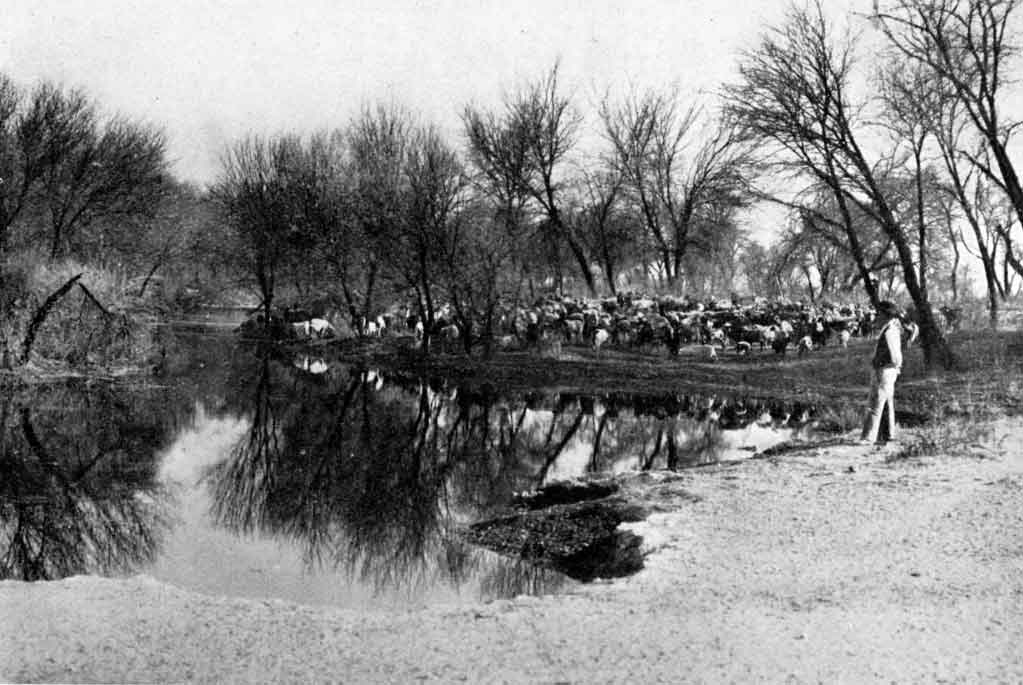
A Beauty Spot passed during the last Trek
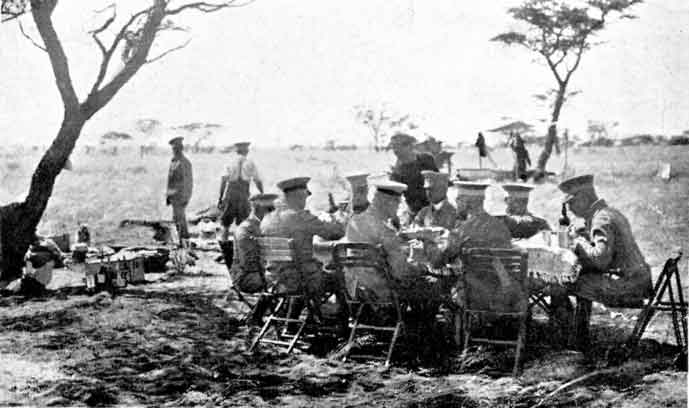
The Last Phase. Conference at Omaruru. German Staff lunching
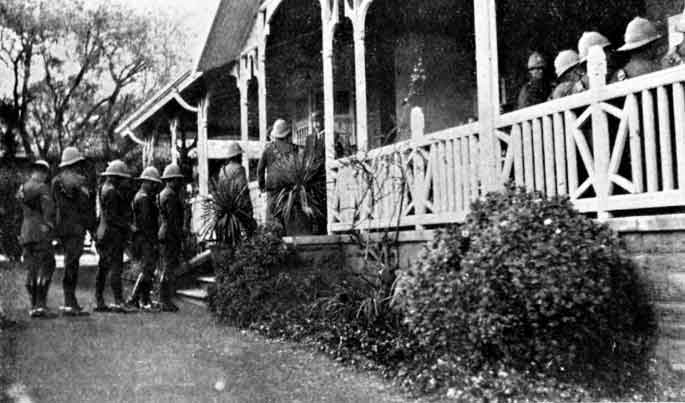
The General receives his Bodyguard at a Garden Party after return
The marvellous series of changes as one advances constitutes the most striking feature of the advance to Windhuk from the coast. By rail it is not so striking; but taking the marching route via the Swakop River water-holes--Swakopmund, Nonidas, Haigamkhab, Husab, Riet, Salem, Wilhelmsfeste (Tsaobis), Otjimbingwe, Windhuk--the changes in the country and the stages that show them are as palpable as if marked by a system of parallel walls. I have never seen this feature of the veld so marked elsewhere in South Africa.
Swakopmund is the limit in the down-grade-- deep sand; brak water; a treacherous, dreary climate, with visitations of furnace-heat desert winds; a huge cemetery; moths and flies. From Nonidas to Haigamkhab and Husab the sand lightens and hardens, the atmosphere improves, rocks, barren kopjes begin to appear; the little water you get is fairly good. Riet comes; the barren kopjes are more frequent; the atmosphere, hot in the day, is beautiful by night; the water is perfect. Salem is a duplicate Riet; a small settlement in the river bed; but the water is more plentiful, the vegetation more profuse. Then comes the great trek to Tsaobis.
It does not look far on the map; it is a huge stretch nevertheless. For the first three hours it was Riet-Salem country with extensions and additions. Vast gorges, black and brown kopjes, boulders, sand stretches, clumps of bush, minute trees. And then, on Thursday the 29th of April (memory holds the date like a vice), we saw grass. It was grass. It was undoubtedly grass--the kind of grass that gave one the feeling that this particular veld, like a man prematurely bald through worry or riotous living, had been trying some hair restorer with ludicrous results--grass whitish, feeble, attenuated, that to be seen at all wanted an eye levelled along the ground.
Each half hour brought its surprise as we moved along, General Botha on his white horse at the head of the column, just visible to the eye through the thick curtain of white dust our horses' feet flung up into the sun glare. We rode in great gorges between kopjes. We crossed dry river courses. We clattered over the hard bosoms of rocks, switchbacked up and down each hour working out of the desert. Trees began to appear--caricatures of trees. Then game spoor was reported. And suddenly, just after noon, rain fell--out of one cloud in a sky otherwise brazenly clear five drops fell. I counted five on my bridle hand.
Rain on the edge of the Namib Desert. It was ludicrous, too bizarre; it was the last straw. We gasped. A deep roar of ironical cheering went up. The Commander-in-Chief looked round and laughed. When we outspanned later the horses made a show of grazing for the first time for five months. The sagacious animals showed plain amazement in their eyes. At Wilhelmsfeste (Tsaobis) the bushveld begins. The water supply of Otjimbingwe is the feature of that rather quaint settlement. One must ever associate it with its fine aeromotor pumping the precious fluid for parched man and beast to drink their full after the desert passage in the shade of cool palms many years old.
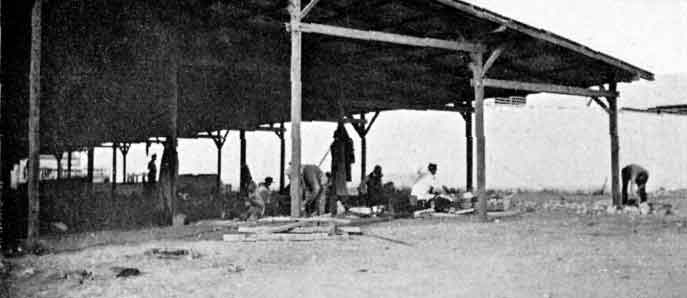
German prisoners of war, imprisoned at Karibib
During the great trek alarms regarding mines were most frequent. There were many wonderful escapes. It seems a marvel that the enemy were not more successful than they were with these deadly machines. Suffer casualties we did; but if all the mines that were laid had blown up our casualties would have been formidable indeed. But somehow those mines seemed foreordained not to act. They were discovered by the merest chance; or they failed to go off; or they exploded at the wrong time.
Making for Karibib in the forenoon of the 5th of May, the authorities naturally showed the greatest caution for the safety of General Botha-- though a large body of Union mounted troops had passed over the same ground before the Commander-in-Chief, Staff and Bodyguard traversed the road.
In view of the fact that the South African Army was operating against the forces of the same nation that has ravaged and despoiled Belgium, a point should be made here. It must be remembered that the armed forces of the Protectorate simply cleared bag and baggage out of all the important inland towns in the face of Botha's overwhelming advances. They left wife and child, the old and infirm, every stick of property they could not carry, at our mercy. When we entered Karibib at five in the evening the non-combatant population were moving about the streets, or standing in best bib and tucker at their doors, calmly gazing at the trek-stained horsemen that sought the nearest water tanks. They had not the slightest fear of us. I spoke to a comrade who has seen war aforetime. He said he had never seen a more orderly occupation of a town.
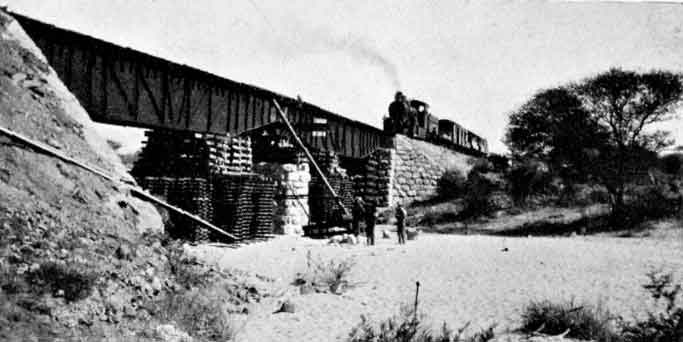
Towards Windhuk. A quick railway repair after the Germans' usual practice
of blowing up railway bridges
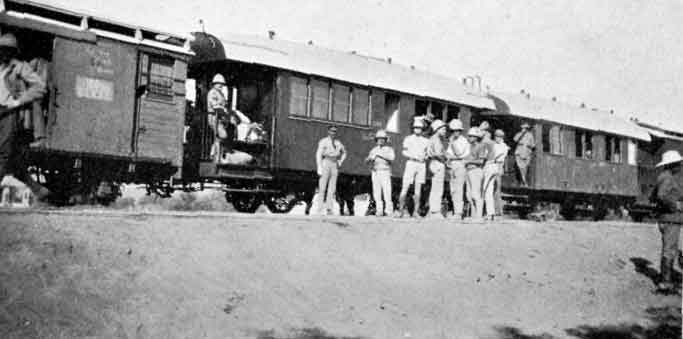
Towards Windhuk. The first train to Windhuk. The South African Engineer
Corps Construction Party aboard
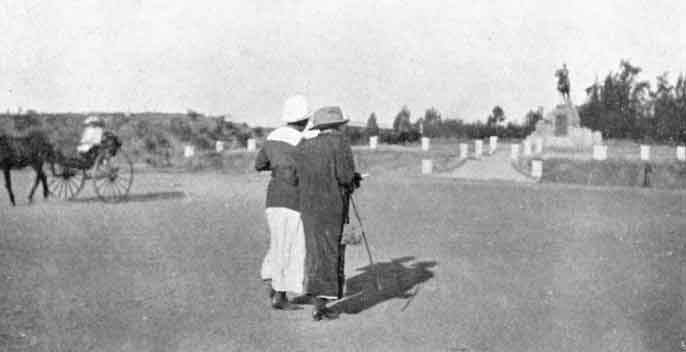
At Windhuk. How we treat the German women. Ten minutes after occupation
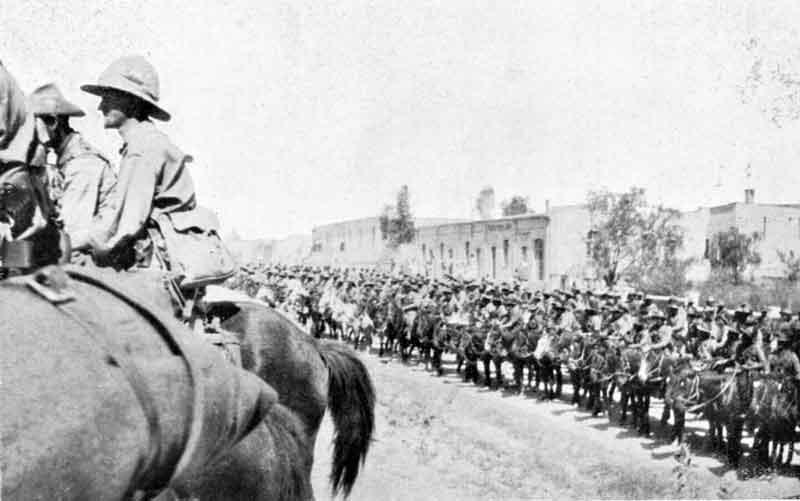
At Windhuk. The Commander-in-Chief addresses his massed troops from
the Rathaus
The conduct of the South African troops should assuredly be noted. The very confidence of these German townspeople that they had nothing to fear from the hated troops of the British Union of South Africa was eloquent. The thing stood out, a piece of bitterest irony in connection with a people whose kindred across the seas were making civilisation shudder at their atrocities afloat and ashore. The news of the _Lusitania_ massacre on the high seas reached Karibib just after occupation. Did one Teuton in the place have to suffer as a consequence even the insult of a word? No. What would the Germans have done? General Botha's forces had crossed a desert through which it was the open boast of the enemy that it was strewn with mines and with every well poisoned. Was a single defenceless citizen of Windhuk or Karibib the worse for it after the occupation? Not one. The greater part of General Botha's forces were on a half--a quarter-- an eighth rations when they made Karibib, Okahandja, Okasise, Waldau and the capital; they lived until all supplies could come up on less than one biscuit a day, a pinch or two of meal, and fresh meat.
How much looting occurred in these towns?
There was none worthy the name.
Everyone was guarded. A few hours after the places were entered the orders were issued threatening severe and instant penalties should any looting be done by the hungry troops; officers, etc., were quietly billeted; and to the houses occupied by women and marged with a white cross no one unauthorised was allowed any approach whatsoever.
It was magnanimous, it was magnificent. But I wonder if the chivalrous Teuton would call it war!
Karibib, the practical junction of the railway running north to Grootfontein, the enemy's new "capital," was made Army Headquarters. General Botha hoisted the flag at Karibib and proclaimed it on the 6th of May, spent a few days settling matters at Karibib, and on the afternoon of the 11th set out for Windhuk by motor, formally to enter the capital. With him the Commander-in-Chief took his Chief of Staff (Colonel Collyer), Lieut.-Colonel de Waal (Provost Marshal), Major Bok (Military Secretary), Major Trew (Officer Commanding Bodyguard), Major Liepoldt (Chief Intelligence Officer), Major Esselen (Staff), an escort from the 4th Battery South African Mounted Riflemen and Bodyguard. Overnight the Headquarters party "outspanned" at Okasise on a beautiful camping-ground, and, meeting the Burgomaster of Windhuk under some trees outside the town, ran into the South-West capital towards noon. Later in the day the ceremony of formal taking over was performed before a big crowd at the Rathaus. It was in every way a historic scene. The mounted troops lined all about the square that fronts the Rathaus from the roadway, their weary horses and stained uniforms showing up in the background, with the throng of civilians crowded amongst the motor-cars and carts in the square itself. A warrant- officer of the Commander-in-Chief's Bodyguard had the honour of hoisting the Union Jack over the Rathaus at Windhuk, the capital of Germany's erstwhile colonial possessions.
A cheer went up as the flag fluttered up in the noon sunlight. Windhuk was naturally regarded as the Mecca, so to speak, of the invading army.
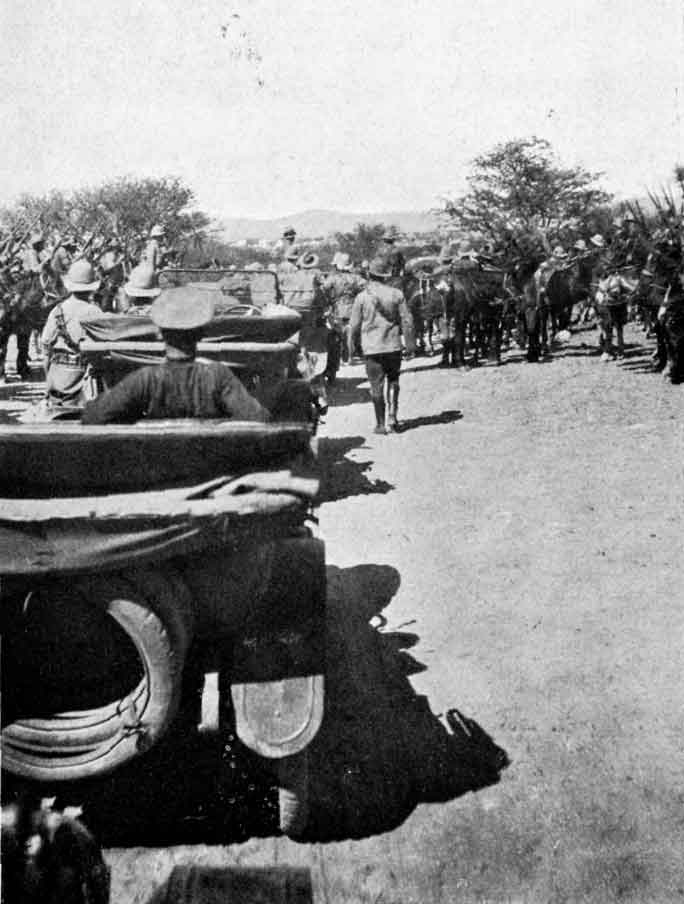
At the Gate of Windhuk. Headquarters Staff Motors awaiting entry
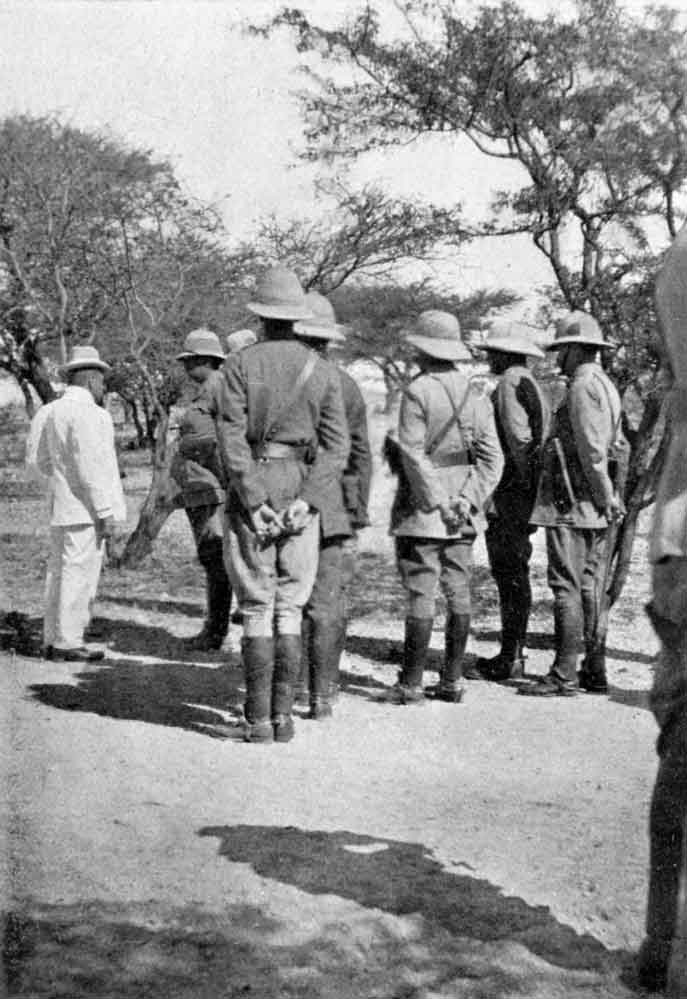
At the Gate of Windhuk. General Botha discusses matters with the Governor
of Windhuk
With the interests of the civilised world fixed on the vast slaughter- grounds of Europe, I shall not spend much time describing Windhuk. It is a pretty, picturesque little town, built amongst brown and purple hills. In most ways it is highly finished; reflects the spirit of German thoroughness that is an admitted attribute of the race. As usual in South-West Africa, it has nothing of the _colonial_ town about it; it might be another suburb of Berlin. Many of the houses are thoroughly built into the sides of the surrounding kopjes--perched like great red- roofed cages on the hillsides. The place doesn't seem to have a single industry of its own; but then, as I said elsewhere, there is hardly an established industry in the Protectorate.
There is one thing about Windhuk that grips your attention--and holds it in no uncertain manner, too. One of the great objectives of the South-West campaign was to secure the Windhuk wireless station. When you see this--catch a glimpse of it suddenly where it stands on the veld outside the town--you get a thrill of sheer astonishment. The thing seems monstrous there. It is foreign to our ideas--a wireless colossus in such a place. Had I seen this vast piece of work in a humming city that stands warden to the seas it would have fitted in. But where it is--well, it just surprised. Fancy a pretty bijou veld town, red roofs, neat church, pepper trees, aeromotors, sleepy people and everything-- and across the veld, a mile and a half away, darkening the sky with great vertical lines, five terrific steel lattice pillars, nearly four hundred feet high, tied by cables with stay bolts as big as a man; their aerials sweep from pillar to pillar, answer to the wind the deepest note of a giant 'cello, and eavesdrop and conjure amongst the news markets of the world. Now there is no electric light in this village of Windhuk, or Windy Corner, yet. What was the idea with this stupendous thing? And there are not enough Germans in the place--or in the whole territory, if it comes to that--to populate a good-sized town. There is also the usual telegraphic communication to the coast, etc. Yet--the wireless.
Its significance could be of one kind only: a military one.
Leaving the town in the hands of Colonel Mentz, Military Governor, and Lieut.-Colonel de Waal, the Commander-in-Chief returned to Headquarters at Karibib on the 14th of May.
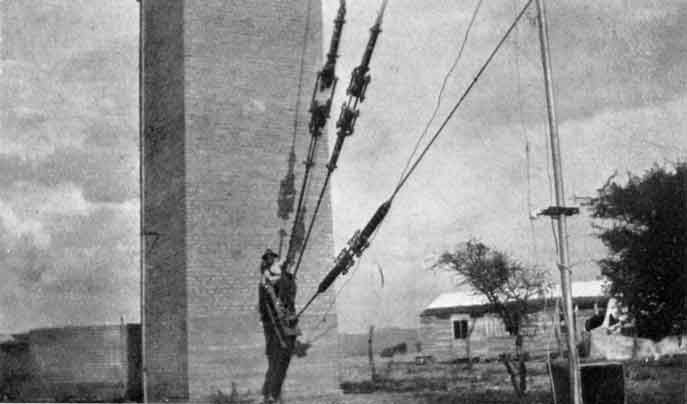
The great Wireless Station at Windhuk
(Note the size of the man as he rests on one of the foundations of
the vast derricks)
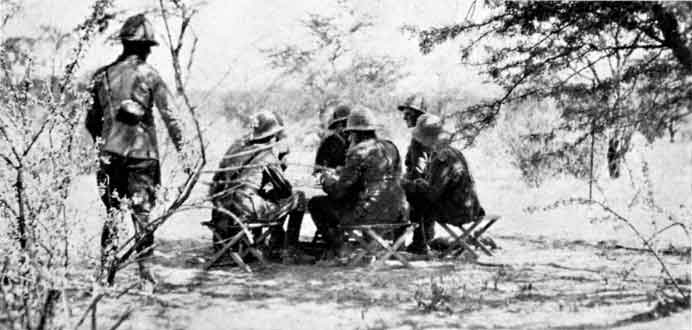
Conference at Omaruru. General Staff lunching
(Photo by Sergeant Ramsay)
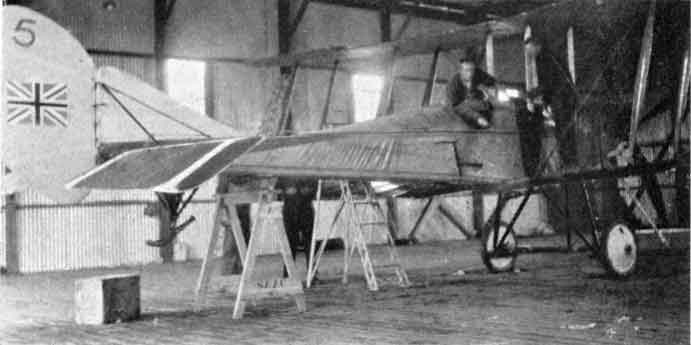
The Last Phase. The BE2 tuning up in shed before flight over German
positions
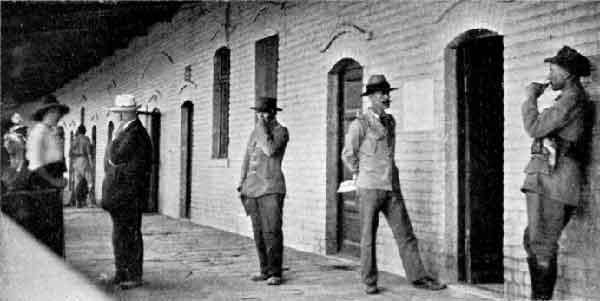
At the Provost Marshal's office at Windhuk--all in Law and order
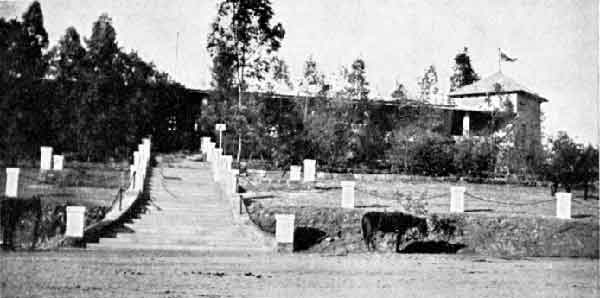
The Union Jack just hoisted at the Governor's office, Windhuk
Nearly five weeks had passed since the Commander-in-Chief had officially proclaimed the capital. During this time much had happened. An abortive conference had taken place at Omaruru itself, the Germans, we were informed afterwards, asking for terms that we were in no mind to give them. The railway line between Swakopmund and Karibib, broken up by dynamited bridges, had been to a great extent repaired. The poorly rationed troops were now replenished. The horses, badly knocked up after the rush through to Windhuk, had had opportunity to mend a bit. General Botha had proclaimed the country; with refreshed troops and horses, he was setting out to attempt to spring a final surprise on the Germans. He had now the Aviation Corps in full working order--had aerial eyes wherewith to be guided through a subtropical bush country very full of possible dangers. He had ahead of him an enemy astonished, yet, if what was rumoured was true, prepared to make a series of fights and a big stand in country of his own choice. He had with him an army that had crossed a desert and, arriving in bush country such as you find in the Rhodesia "low" veld, knew the nature of it as only the South African can.
On June 24 Headquarters ran into Kalkfeld just after midnight. The enemy had retreated. It had been predicted with the utmost confidence that the Germans would here put up a fight. So confidently was this expected that the Commander-in-Chief would hardly believe it when the aeroplanes returned and reported that there were about half a dozen Germans left in the place. Yet that proved to be exactly the fact, and so greatly impressed was General Botha with the accuracy of the observations on this occasion that he emphasised that the skymen were to receive every possible assistance for the future.
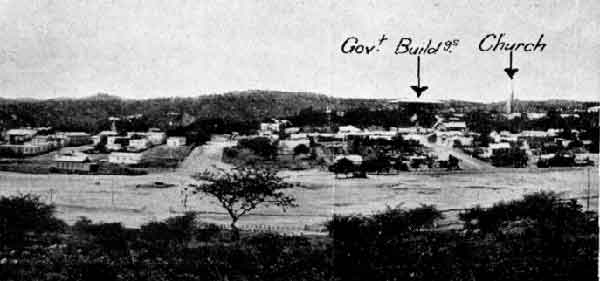
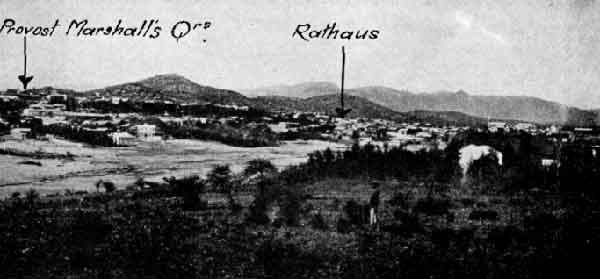
Panorama of Windhuk
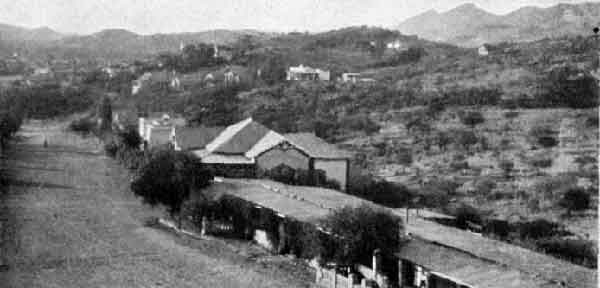
Picturesque Windhuk : photograph showing the houses nestling in the
hills, taken from the church.
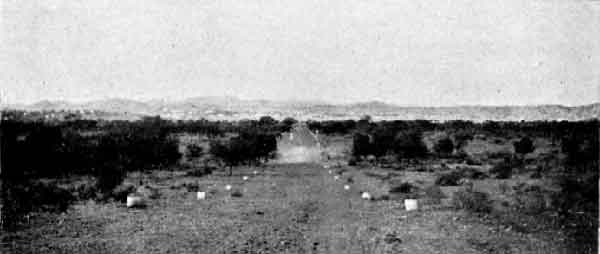
Windhuk. Basking in the sun: from the great Wireless Station
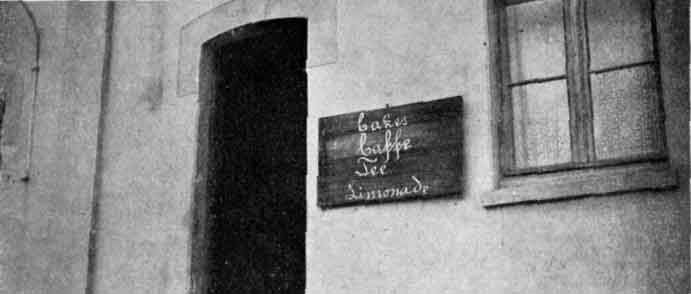
How the Germans started to try trading with us ten minutes after we
entered the Capital. Note the spelling
On June 26 Headquarters arrived at Okanjande, and pushed through to Otjiwarongo, arriving there at 12 noon. The pace of the trekking was now becoming phenomenal, and though the country was quite good, water was as scarce as ever, the bush being intensely dense, with thick sweet grass as much as eight feet high in places. It was a country made for ambushes. In less than a week General Botha had trekked over one hundred and twenty miles, the distance from Karibib to Otjiwarongo. During this trek the army had had water only twice on the stretch from Omaruru. But delay of any kind was now highly undesirable: the columns could not afford to pause long owing to the consumption of rations. It was no part of the Commander-in-Chief's policy to make bases and await the arrival of large supplies; water was uncertain, and congestion of columns at the watering places had to be avoided as much as possible.
Near Okanjande the first great development in General Botha's final strategy occurred. The northern advance was being conducted as follows. Brigadier-General Brits, on the left, remained at Otjitasu, leaving it on June 30. General Botha, with his command, in the centre, was holding to the narrow gauge Karibib-Otavi-Tsumeb-Grootfontein Railway, and General Myburgh's column to the right. Brigadier-General Brits now branched away to Otjitasu, making for Outjo, Okanknejo, and across the Etoscha Pan to Namutoni. The other columns moved on, trekking night and day, as in the great advance across the Namib Desert.
Headquarters made Okaputa on June 29; paused the next day, and on July 1 the Staff, leaving Okaputa at 8 o'clock in the morning, reached Otavi and Otaviafontein at 4.30 p.m., close on the heels of an engagement at Osib between the Germans and Brigadier-General Manie Botha, who had pushed on with the Orange Free State Brigade at 6.30 the previous evening, June 30. This engagement took place in the now intensely thick bush country. In defeating the enemy, at a cost of a dozen casualties, Brigadier-General Manie Botha succeeded in securing the finest water supply the Union Forces had yet seen, and so swift and resolute was the fighting of the burghers that the enemy fled to their last strong-hold northward towards Tsumeb. Before striking the enemy in this action the Free State Brigade, and their accompanying batteries from the 2nd South African Mounted Riflemen, had trekked forty-two miles in sixteen hours without halt for any kind of a rest. Behind them, in support, came the force, consisting of the 6th Mounted Brigade, with the 1st South African Mounted Riflemen Batteries, who did a similar trek, through thickest bush, covering almost fifty miles in twenty hours. And the animals had come through from Karibib--almost two and a half degrees of latitude south.
At the same time as Brigadier-General Manie Botha had left Okaputa, Brigadier-General Lukin, with the 6th Mounted S.A.M.R. Brigade, had left Omarasa. We had therefore a perfect network of highly mobile forces advancing on the German position somewhere north. Away on the right, from Windhuk and Okahandja through the Waterberg, was Brigadier- General Albert's column. On his left was Brigadier-General Myburgh. Nearer the railway was Brigadier-General Manie Botha. Next came the Commander-in-Chief with Headquarters Staff and Bodyguard; and, further, General Lukin. For the time being Brigadier-General Brits, on the extreme left, had disappeared.
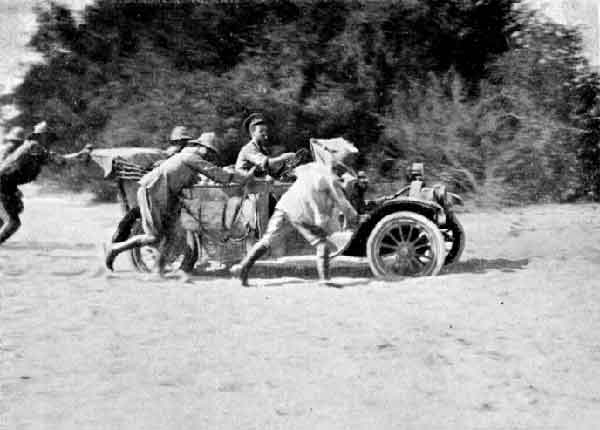
The Last Phase. Difficulties with General Botha's car through the thick
sand
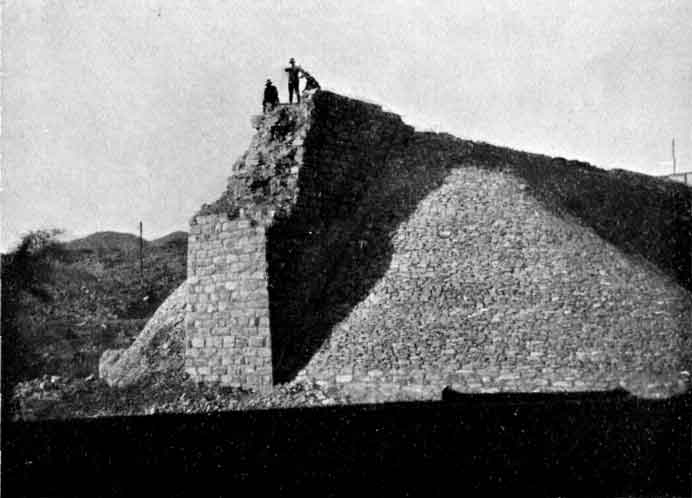
The Last Phase. The Germans had a hobby of blowing up bridges. Here
is a fine specimen
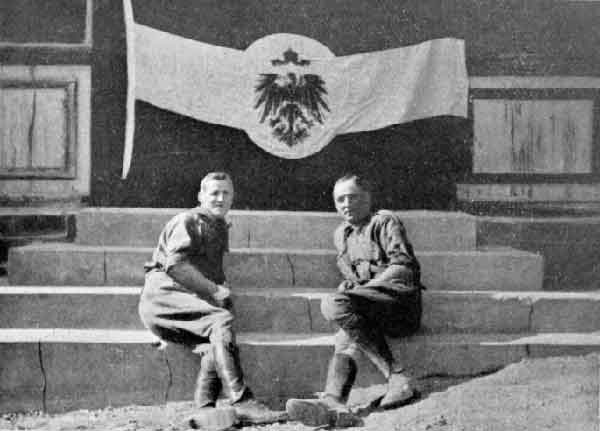
General Frank's house, Windhuk. Photo of the two first men there taken
under the flag hauled down by us
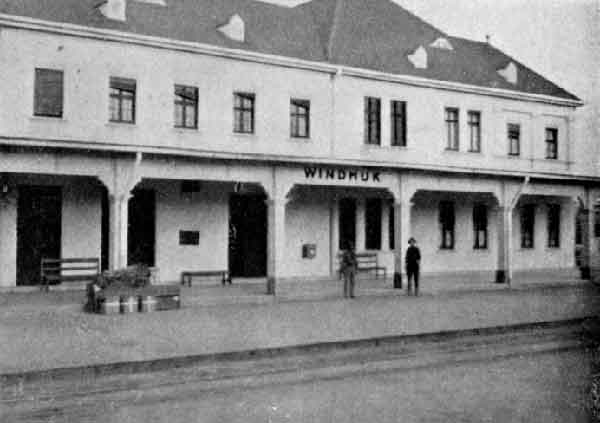
Windhuk. The first British station-master and one of his staff
Brigadier-General Manie Botha now advanced right into the bush, supported by Brigadier-General Lukin, who occupied Eisenberg Nek, on the right flank. Brigadier-General Myburgh, trekking by forced marches, in the course of his flanking movement on the right cut the line between Otavi and Grootfontein, and, swerving north, encountered the enemy at Asis and Gaub. This column, having captured seventy Germans, marched straight on to Tsumeb, the extreme northerly limit of the railway, forty miles north of Otavi. Here the enemy was attacked so resolutely that they surrendered with all arms and four field guns, and the Union prisoners of war were released. And great was their rejoicing, too. Other columns marching north had now reached Rietfontein and Grootfontein.
It so arose now that General Myburgh, having got for a brief space out of touch with the Commander-in-Chief, was not aware that the Germans had opened, on July 5, negotiations with General Botha. General Myburgh was at once communicated with. As a fact, at the time he entered Tsumeb, a conference was on hand farther south.
Why did the German forces in the Protectorate surrender without making the big stand they threatened? If any proof be needed that they did intend to make a stand it is necessary only to glance at the plan of their final dispositions. And that is just where General Botha and his forces had done their work. There is not the least doubt, not the very least, that von Franke might have made a stand. It would have been nothing more than a quixotically honourable waste of life ending in one only possible way.
He was surrounded before he knew it.
So neat and swift had been the scheme prepared by the Commander-in- Chief that the German was incredulous--until his scouts kept coming in and telling him what the real state of affairs was. For Brits, after a two hundred mile detour through the wildest country had swept right north to Namutoni on the Great Etoscha Pan, had released more prisoners and was swerving further out. Myburgh was in Tsumeb. Both these generals were behind the Germans, ready to strike out forthwith; and von Franke was cut off from all his supplies. He had simply been caught--caught by remorseless forced marches and strategy as neat as a trivet--in a great fork with bent prongs. On the sketches in this little book, to which I have sacrificed everything possible for clearness, the general simple scheme of the campaign may be apparent. The final position on July 5 was something like the diagram on page 61 [below]
Even guerilla warfare is an unattainable luxury when you are surrounded.
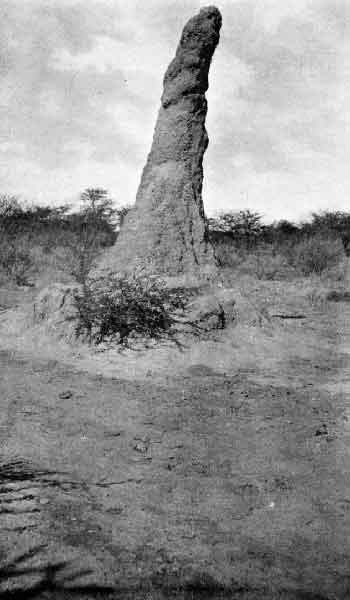
The Last Phase. Opposite the very spot where surrender was made. A
vast ant-hill at 500 Kilometres
[Illustration: South-West Africa. Position of enemy before surrender] [missing]
At kilometre 500 on the line between Otavi and Korab, at 2 a.m. on the 9th of July 1915, von Franke, the German Commander, and Dr. Seitz, the Imperial Governor of South-West Africa, discreetly surrendered to Louis Botha, Commander-in-Chief and Prime Minister of the Union of South Africa.
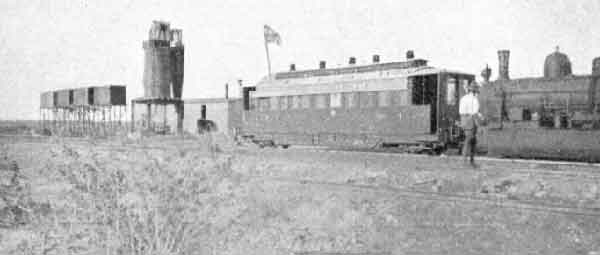
The Last Phase. The German white flag train just arriving
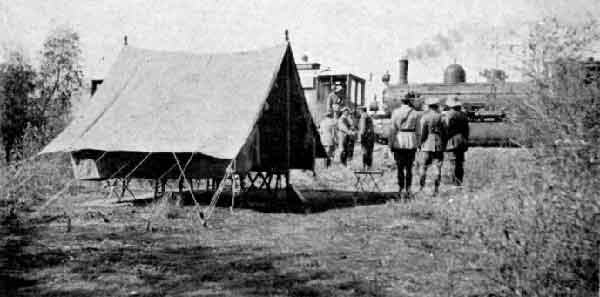
The Last Phase. General Botha meets Von Franke at 500 Kilometres
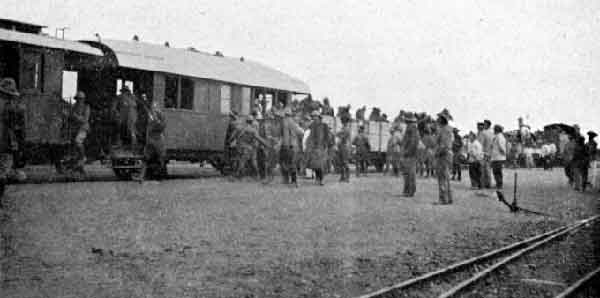
The Last Phase. Troops entraining to return home
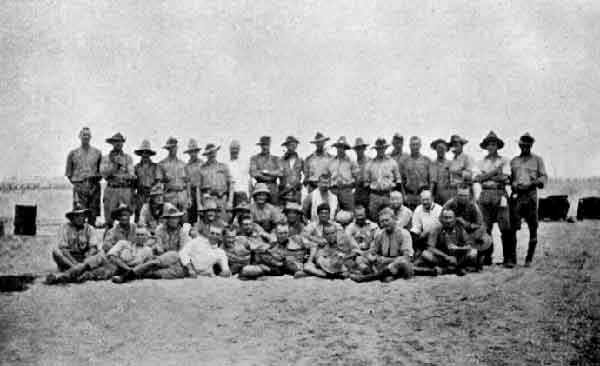
The Last Phase. The famous Rhodesian Regiment that did so much in the
final brilliant movement
(1) The military forces of the Protectorate of German South-West Africa (hereinafter referred to as the Protectorate) remaining in the field under arms and at the disposal and the command of the commander of the said Protectorate forces, are hereby surrendered to General the Right Hon. Louis Botha, Commander-in-Chief of the Forces of the Union of South Africa in the field. Brigadier-General H. T. Lukin, C.M.G., D.S.O., acting on behalf of General Botha, shall be the officer in charge with arranging details of the surrender and giving effect to it.
(2) The active troops of the said forces of the said Protectorate surrendered in terms of paragraph (1) shall, in the case of officers, retain their arms and may give parole, being allowed to live each under that parole at such places as he may select. If for any reason the Government of the Union is unable to meet the wish of any officer as regards choice of abode, the officer concerned will choose some place in respect of which no difficulty exists. In the case of other ranks of the active troops of the said forces of the Protectorate, such other ranks shall be interned under proper guard at such place in the Protectorate as the Union Government shall decide upon.
(3) Each non-commissioned officer and man of the ranks last referred to shall be allowed to retain their rifles, but no ammunition. One officer shall be permitted to be interned with the other ranks of artillery, and one with the other ranks of the remainder of the active troops, and one with the other ranks of the police.
(4) All reservists (Landwehr) of all ranks of the said forces of the Protectorate now remaining under arms in the field shall, except to the extent as is provided for in paragraph (6) below, give up their arms upon being surrendered, in such formations as may be found most convenient, and after signing the annexed form of parole shall be allowed to return to their homes and resume civil occupation.
(5) All reservists (Landwehr and Landsturm) of all ranks of the said forces of the Protectorate who are now held by the Union Government as prisoners of war taken from the forces of the Protectorate, upon signing the form of parole above mentioned in paragraph (4), shall be allowed to resume civil occupation in the Protectorate.
(6) Officers of the Reserve (Landwehr and Landsturm) of the said forces of the Protectorate who surrender in terms of paragraph (1) above shall be allowed to retain their arms, provided they sign the parole above mentioned in paragraph (4).
(7) All the officers of the said forces of the Protectorate who sign the form of parole above mentioned in paragraph (4) shall be allowed to retain their horses, which are nominally allotted to them in the military establishment.
(8) The Police of the Protectorate shall be treated, as far as have been mobilised, as active troops. Those members of the Police who are on duty on distant stations shall remain at their posts until relieved by the Union troops, in order that the lives and property of non- combatants may be protected.
(9) Civil officials in the employment of the German Government of the Protectorate shall be allowed to remain in their homes provided they sign the parole above mentioned in paragraph (4). Nothing, however, in this statement to be construed as entitling any such official to exercise the functions of the appointment which he holds in the service of either of the Governments aforesaid, or to claim from the Union Government the emoluments of such appointment.
(10)With the exception of the arms retained by the officers of the Protectorate forces and by other ranks of the active troops, as provided in paragraph (2), all war material (including all field guns, mountain guns, small arms and guns, and small arm ammunition), and the whole of the property of the Government of the Protectorate, shall be placed at the disposal of the Union Government.
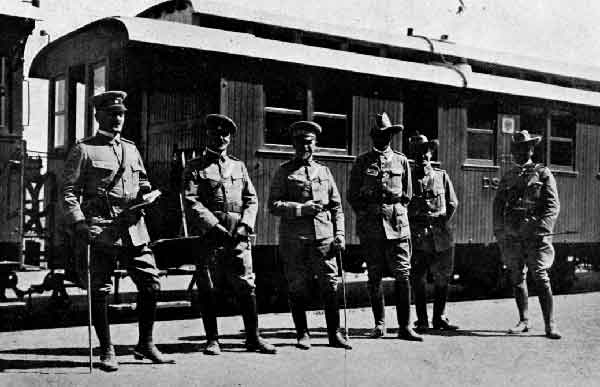
The German Staff before surrender
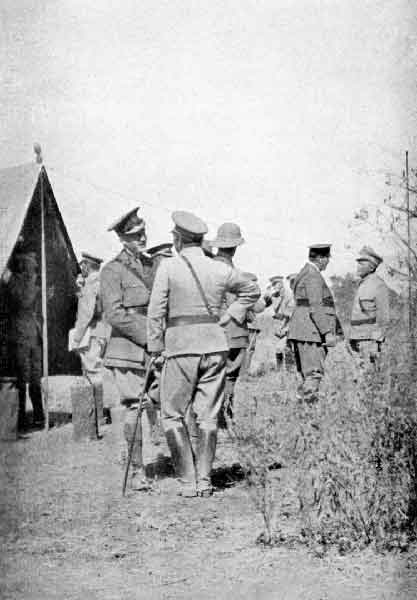
General Botha and his brilliant Chief of Staff, Colonel J.F. Collier,
meet Von Franke at 500 Kilometres
(11) His Excellency the Imperial Governor shall appoint a civil official of the Protectorate Service who shall hand over and keep a record of all Government property of the Civil Departments, including records which are handed over to the Union Government in terms of paragraph (10), and the Commander of the said forces of the Protectorate shall appoint military officers, who shall hand over and keep a similar record of all Government Property of the Military Department of the Protectorate.
Given under our hand this 19th day of July 1915.
(Signed) Louis BOTHA,
General Commanding-in-Chief of the Union Forces in the Field.
SEITZ,
Imperial Governor of German South-West Africa.
FRANKE,
Lieut.-Colonel, Commander of the Protectorate Forces of German South- West Africa.
The form of parole, shown as an annexure, begins--
"I, the undersigned, hereby place myself on my honour not to re-engage in hostilities in the present war between Great Britain and Germany."
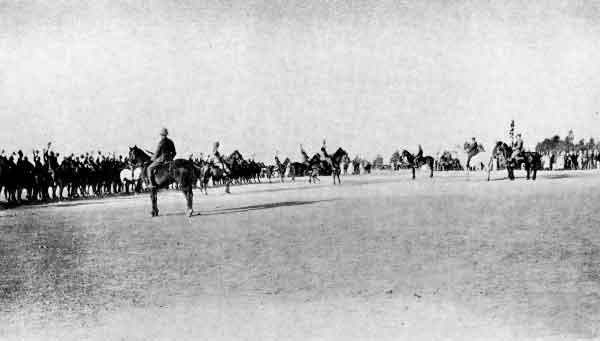
The Last Phase. The Commander-in-Chief, General Botha, receives an
ovation from his Bodyguard after disbanding them
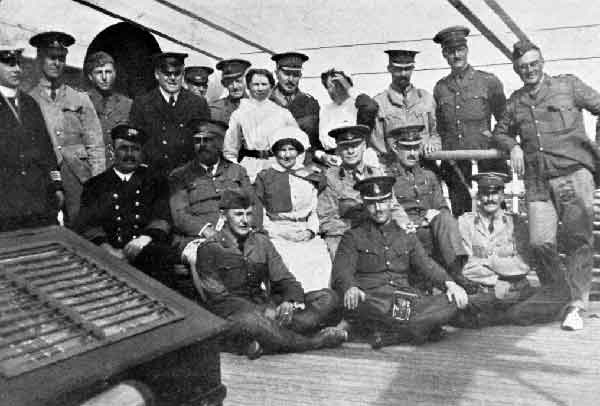
Homeward bound! General Botha and Staff returning on the Ebari
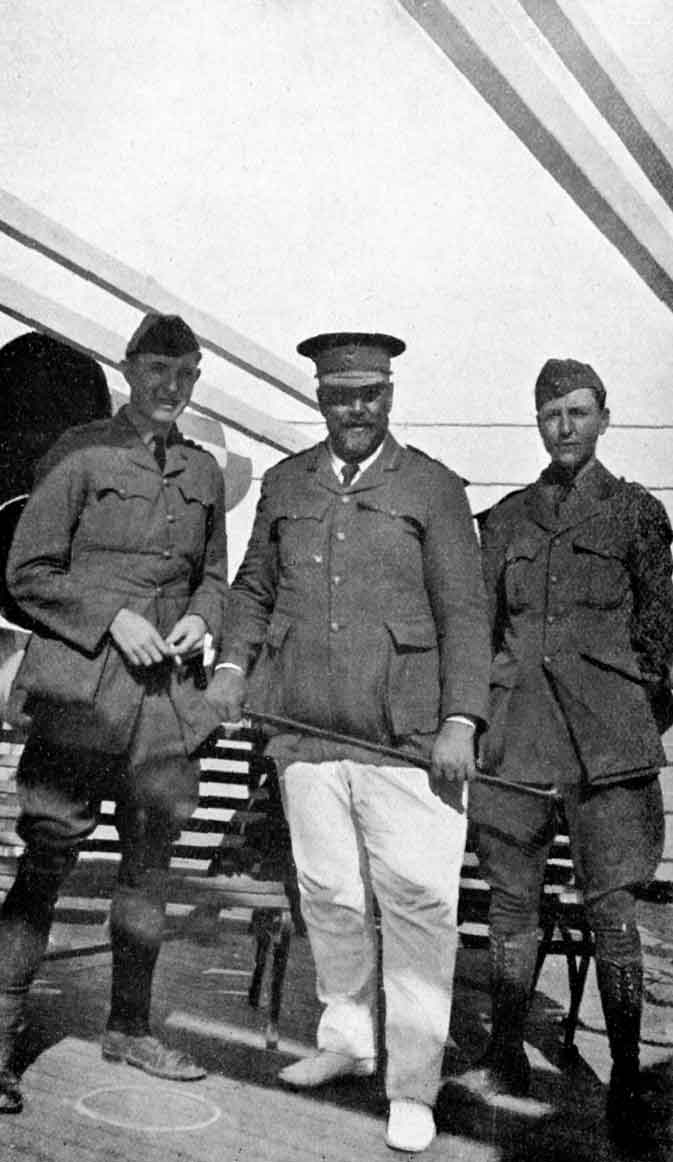
The Great Man and the Chips of the Old Block returning to the Union
after Conquest
Killed in action 88 Died of wounds 25 Wounded in action 263 Wounded and taken prisoners 48 Unwounded prisoners in hands of enemy 612 Total 1,036
Died of disease 97 Died through accidents and by mis-adventure 56 Total 153
Officers of the Active Troops and Police 110 Officers of the Reserve 177 Rank and File of Active Troops and Police 1,548 Rank and File of Reserve 2,575
The Union Forces when at greatest strength numbered 50,000 men.
The Germans when at full strength numbered 9,000, but a proportion of these consisted of civilians, who eventually refused to serve.
The additional numbers captured or surrendered at various points since General Botha made his advance northwards after occupation of Windhuk are--
To Brigadier-General Myburgh's force, mostly at Gaub 105
To Brigadier-General Manie Botha's force between Okaputa and Otavifontein 50
To Brigadier-General Lukin's force 12
To Brigadier-General Brits' force, mostly at Namutoni 163
Total 330 Thus the total number of prisoners taken during the last stage of the campaign, viz. from June 18 to July 9, was 4,740.
***END OF THE PROJECT GUTENBERG EBOOK WITH BOTHA IN THE FIELD***
******* This file should be named 15802-h.txt or 15802-h.zip *******
This and all associated files of various formats will be found in:
http://www.gutenberg.org/1/5/8/0/15802
Updated editions will replace the previous one--the old editions will be renamed.
Creating the works from public domain print editions means that no one owns a United States copyright in these works, so the Foundation (and you!) can copy and distribute it in the United States without permission and without paying copyright royalties. Special rules, set forth in the General Terms of Use part of this license, apply to copying and distributing Project Gutenberg-tm electronic works to protect the PROJECT GUTENBERG-tm concept and trademark. Project Gutenberg is a registered trademark, and may not be used if you charge for the eBooks, unless you receive specific permission. If you do not charge anything for copies of this eBook, complying with the rules is very easy. You may use this eBook for nearly any purpose such as creation of derivative works, reports, performances and research. They may be modified and printed and given away--you may do practically ANYTHING with public domain eBooks. Redistribution is subject to the trademark license, especially commercial redistribution.
*** START: FULL LICENSE ***
THE FULL PROJECT GUTENBERG LICENSE
PLEASE READ THIS BEFORE YOU DISTRIBUTE OR USE THIS WORK
To protect the Project Gutenberg-tm mission of promoting the free
distribution of electronic works, by using or distributing this work
(or any other work associated in any way with the phrase "Project
Gutenberg"), you agree to comply with all the terms of the Full Project
Gutenberg-tm License (available with this file or online at
http://gutenberg.org/license).
Section 1. General Terms of Use and Redistributing Project Gutenberg-tm
electronic works
1.A. By reading or using any part of this Project Gutenberg-tm
electronic work, you indicate that you have read, understand, agree to
and accept all the terms of this license and intellectual property
(trademark/copyright) agreement. If you do not agree to abide by all
the terms of this agreement, you must cease using and return or destroy
all copies of Project Gutenberg-tm electronic works in your possession.
If you paid a fee for obtaining a copy of or access to a Project
Gutenberg-tm electronic work and you do not agree to be bound by the
terms of this agreement, you may obtain a refund from the person or
entity to whom you paid the fee as set forth in paragraph 1.E.8.
1.B. "Project Gutenberg" is a registered trademark. It may only be
used on or associated in any way with an electronic work by people who
agree to be bound by the terms of this agreement. There are a few
things that you can do with most Project Gutenberg-tm electronic works
even without complying with the full terms of this agreement. See
paragraph 1.C below. There are a lot of things you can do with Project
Gutenberg-tm electronic works if you follow the terms of this agreement
and help preserve free future access to Project Gutenberg-tm electronic
works. See paragraph 1.E below.
1.C. The Project Gutenberg Literary Archive Foundation ("the Foundation"
or PGLAF), owns a compilation copyright in the collection of Project
Gutenberg-tm electronic works. Nearly all the individual works in the
collection are in the public domain in the United States. If an
individual work is in the public domain in the United States and you are
located in the United States, we do not claim a right to prevent you from
copying, distributing, performing, displaying or creating derivative
works based on the work as long as all references to Project Gutenberg
are removed. Of course, we hope that you will support the Project
Gutenberg-tm mission of promoting free access to electronic works by
freely sharing Project Gutenberg-tm works in compliance with the terms of
this agreement for keeping the Project Gutenberg-tm name associated with
the work. You can easily comply with the terms of this agreement by
keeping this work in the same format with its attached full Project
Gutenberg-tm License when you share it without charge with others.
1.D. The copyright laws of the place where you are located also govern
what you can do with this work. Copyright laws in most countries are in
a constant state of change. If you are outside the United States, check
the laws of your country in addition to the terms of this agreement
before downloading, copying, displaying, performing, distributing or
creating derivative works based on this work or any other Project
Gutenberg-tm work. The Foundation makes no representations concerning
the copyright status of any work in any country outside the United
States.
1.E. Unless you have removed all references to Project Gutenberg:
1.E.1. The following sentence, with active links to, or other immediate
access to, the full Project Gutenberg-tm License must appear prominently
whenever any copy of a Project Gutenberg-tm work (any work on which the
phrase "Project Gutenberg" appears, or with which the phrase "Project
Gutenberg" is associated) is accessed, displayed, performed, viewed,
copied or distributed:
This eBook is for the use of anyone anywhere at no cost and with
almost no restrictions whatsoever. You may copy it, give it away or
re-use it under the terms of the Project Gutenberg License included
with this eBook or online at www.gutenberg.org
1.E.2. If an individual Project Gutenberg-tm electronic work is derived
from the public domain (does not contain a notice indicating that it is
posted with permission of the copyright holder), the work can be copied
and distributed to anyone in the United States without paying any fees
or charges. If you are redistributing or providing access to a work
with the phrase "Project Gutenberg" associated with or appearing on the
work, you must comply either with the requirements of paragraphs 1.E.1
through 1.E.7 or obtain permission for the use of the work and the
Project Gutenberg-tm trademark as set forth in paragraphs 1.E.8 or
1.E.9.
1.E.3. If an individual Project Gutenberg-tm electronic work is posted
with the permission of the copyright holder, your use and distribution
must comply with both paragraphs 1.E.1 through 1.E.7 and any additional
terms imposed by the copyright holder. Additional terms will be linked
to the Project Gutenberg-tm License for all works posted with the
permission of the copyright holder found at the beginning of this work.
1.E.4. Do not unlink or detach or remove the full Project Gutenberg-tm
License terms from this work, or any files containing a part of this
work or any other work associated with Project Gutenberg-tm.
1.E.5. Do not copy, display, perform, distribute or redistribute this
electronic work, or any part of this electronic work, without
prominently displaying the sentence set forth in paragraph 1.E.1 with
active links or immediate access to the full terms of the Project
Gutenberg-tm License.
1.E.6. You may convert to and distribute this work in any binary,
compressed, marked up, nonproprietary or proprietary form, including any
word processing or hypertext form. However, if you provide access to or
distribute copies of a Project Gutenberg-tm work in a format other than
"Plain Vanilla ASCII" or other format used in the official version
posted on the official Project Gutenberg-tm web site (www.gutenberg.org),
you must, at no additional cost, fee or expense to the user, provide a
copy, a means of exporting a copy, or a means of obtaining a copy upon
request, of the work in its original "Plain Vanilla ASCII" or other
form. Any alternate format must include the full Project Gutenberg-tm
License as specified in paragraph 1.E.1.
1.E.7. Do not charge a fee for access to, viewing, displaying,
performing, copying or distributing any Project Gutenberg-tm works
unless you comply with paragraph 1.E.8 or 1.E.9.
1.E.8. You may charge a reasonable fee for copies of or providing
access to or distributing Project Gutenberg-tm electronic works provided
that
- You pay a royalty fee of 20% of the gross profits you derive from
the use of Project Gutenberg-tm works calculated using the method
you already use to calculate your applicable taxes. The fee is
owed to the owner of the Project Gutenberg-tm trademark, but he
has agreed to donate royalties under this paragraph to the
Project Gutenberg Literary Archive Foundation. Royalty payments
must be paid within 60 days following each date on which you
prepare (or are legally required to prepare) your periodic tax
returns. Royalty payments should be clearly marked as such and
sent to the Project Gutenberg Literary Archive Foundation at the
address specified in Section 4, "Information about donations to
the Project Gutenberg Literary Archive Foundation."
- You provide a full refund of any money paid by a user who notifies
you in writing (or by e-mail) within 30 days of receipt that s/he
does not agree to the terms of the full Project Gutenberg-tm
License. You must require such a user to return or
destroy all copies of the works possessed in a physical medium
and discontinue all use of and all access to other copies of
Project Gutenberg-tm works.
- You provide, in accordance with paragraph 1.F.3, a full refund of any
money paid for a work or a replacement copy, if a defect in the
electronic work is discovered and reported to you within 90 days
of receipt of the work.
- You comply with all other terms of this agreement for free
distribution of Project Gutenberg-tm works.
1.E.9. If you wish to charge a fee or distribute a Project Gutenberg-tm
electronic work or group of works on different terms than are set
forth in this agreement, you must obtain permission in writing from
both the Project Gutenberg Literary Archive Foundation and Michael
Hart, the owner of the Project Gutenberg-tm trademark. Contact the
Foundation as set forth in Section 3 below.
1.F.
1.F.1. Project Gutenberg volunteers and employees expend considerable
effort to identify, do copyright research on, transcribe and proofread
public domain works in creating the Project Gutenberg-tm
collection. Despite these efforts, Project Gutenberg-tm electronic
works, and the medium on which they may be stored, may contain
"Defects," such as, but not limited to, incomplete, inaccurate or
corrupt data, transcription errors, a copyright or other intellectual
property infringement, a defective or damaged disk or other medium, a
computer virus, or computer codes that damage or cannot be read by
your equipment.
1.F.2. LIMITED WARRANTY, DISCLAIMER OF DAMAGES - Except for the "Right
of Replacement or Refund" described in paragraph 1.F.3, the Project
Gutenberg Literary Archive Foundation, the owner of the Project
Gutenberg-tm trademark, and any other party distributing a Project
Gutenberg-tm electronic work under this agreement, disclaim all
liability to you for damages, costs and expenses, including legal
fees. YOU AGREE THAT YOU HAVE NO REMEDIES FOR NEGLIGENCE, STRICT
LIABILITY, BREACH OF WARRANTY OR BREACH OF CONTRACT EXCEPT THOSE
PROVIDED IN PARAGRAPH F3. YOU AGREE THAT THE FOUNDATION, THE
TRADEMARK OWNER, AND ANY DISTRIBUTOR UNDER THIS AGREEMENT WILL NOT BE
LIABLE TO YOU FOR ACTUAL, DIRECT, INDIRECT, CONSEQUENTIAL, PUNITIVE OR
INCIDENTAL DAMAGES EVEN IF YOU GIVE NOTICE OF THE POSSIBILITY OF SUCH
DAMAGE.
1.F.3. LIMITED RIGHT OF REPLACEMENT OR REFUND - If you discover a
defect in this electronic work within 90 days of receiving it, you can
receive a refund of the money (if any) you paid for it by sending a
written explanation to the person you received the work from. If you
received the work on a physical medium, you must return the medium with
your written explanation. The person or entity that provided you with
the defective work may elect to provide a replacement copy in lieu of a
refund. If you received the work electronically, the person or entity
providing it to you may choose to give you a second opportunity to
receive the work electronically in lieu of a refund. If the second copy
is also defective, you may demand a refund in writing without further
opportunities to fix the problem.
1.F.4. Except for the limited right of replacement or refund set forth
in paragraph 1.F.3, this work is provided to you 'AS-IS,' WITH NO OTHER
WARRANTIES OF ANY KIND, EXPRESS OR IMPLIED, INCLUDING BUT NOT LIMITED TO
WARRANTIES OF MERCHANTIBILITY OR FITNESS FOR ANY PURPOSE.
1.F.5. Some states do not allow disclaimers of certain implied
warranties or the exclusion or limitation of certain types of damages.
If any disclaimer or limitation set forth in this agreement violates the
law of the state applicable to this agreement, the agreement shall be
interpreted to make the maximum disclaimer or limitation permitted by
the applicable state law. The invalidity or unenforceability of any
provision of this agreement shall not void the remaining provisions.
1.F.6. INDEMNITY - You agree to indemnify and hold the Foundation, the
trademark owner, any agent or employee of the Foundation, anyone
providing copies of Project Gutenberg-tm electronic works in accordance
with this agreement, and any volunteers associated with the production,
promotion and distribution of Project Gutenberg-tm electronic works,
harmless from all liability, costs and expenses, including legal fees,
that arise directly or indirectly from any of the following which you do
or cause to occur: (a) distribution of this or any Project Gutenberg-tm
work, (b) alteration, modification, or additions or deletions to any
Project Gutenberg-tm work, and (c) any Defect you cause.
Section 2. Information about the Mission of Project Gutenberg-tm
Project Gutenberg-tm is synonymous with the free distribution of
electronic works in formats readable by the widest variety of computers
including obsolete, old, middle-aged and new computers. It exists
because of the efforts of hundreds of volunteers and donations from
people in all walks of life.
Volunteers and financial support to provide volunteers with the
assistance they need, is critical to reaching Project Gutenberg-tm's
goals and ensuring that the Project Gutenberg-tm collection will
remain freely available for generations to come. In 2001, the Project
Gutenberg Literary Archive Foundation was created to provide a secure
and permanent future for Project Gutenberg-tm and future generations.
To learn more about the Project Gutenberg Literary Archive Foundation
and how your efforts and donations can help, see Sections 3 and 4
and the Foundation web page at http://www.gutenberg.org/fundraising/pglaf.
Section 3. Information about the Project Gutenberg Literary Archive
Foundation
The Project Gutenberg Literary Archive Foundation is a non profit
501(c)(3) educational corporation organized under the laws of the
state of Mississippi and granted tax exempt status by the Internal
Revenue Service. The Foundation's EIN or federal tax identification
number is 64-6221541. Contributions to the Project Gutenberg
Literary Archive Foundation are tax deductible to the full extent
permitted by U.S. federal laws and your state's laws.
The Foundation's principal office is located at 4557 Melan Dr. S.
Fairbanks, AK, 99712., but its volunteers and employees are scattered
throughout numerous locations. Its business office is located at
809 North 1500 West, Salt Lake City, UT 84116, (801) 596-1887, email
[email protected]. Email contact links and up to date contact
information can be found at the Foundation's web site and official
page at http://www.gutenberg.org/about/contact
For additional contact information:
Dr. Gregory B. Newby
Chief Executive and Director
[email protected]
Section 4. Information about Donations to the Project Gutenberg
Literary Archive Foundation
Project Gutenberg-tm depends upon and cannot survive without wide
spread public support and donations to carry out its mission of
increasing the number of public domain and licensed works that can be
freely distributed in machine readable form accessible by the widest
array of equipment including outdated equipment. Many small donations
($1 to $5,000) are particularly important to maintaining tax exempt
status with the IRS.
The Foundation is committed to complying with the laws regulating
charities and charitable donations in all 50 states of the United
States. Compliance requirements are not uniform and it takes a
considerable effort, much paperwork and many fees to meet and keep up
with these requirements. We do not solicit donations in locations
where we have not received written confirmation of compliance. To
SEND DONATIONS or determine the status of compliance for any
particular state visit http://www.gutenberg.org/fundraising/pglaf
While we cannot and do not solicit contributions from states where we
have not met the solicitation requirements, we know of no prohibition
against accepting unsolicited donations from donors in such states who
approach us with offers to donate.
International donations are gratefully accepted, but we cannot make
any statements concerning tax treatment of donations received from
outside the United States. U.S. laws alone swamp our small staff.
Please check the Project Gutenberg Web pages for current donation
methods and addresses. Donations are accepted in a number of other
ways including including checks, online payments and credit card
donations. To donate, please visit:
http://www.gutenberg.org/fundraising/donate
Section 5. General Information About Project Gutenberg-tm electronic
works.
Professor Michael S. Hart is the originator of the Project Gutenberg-tm
concept of a library of electronic works that could be freely shared
with anyone. For thirty years, he produced and distributed Project
Gutenberg-tm eBooks with only a loose network of volunteer support.
Project Gutenberg-tm eBooks are often created from several printed
editions, all of which are confirmed as Public Domain in the U.S.
unless a copyright notice is included. Thus, we do not necessarily
keep eBooks in compliance with any particular paper edition.
Each eBook is in a subdirectory of the same number as the eBook's
eBook number, often in several formats including plain vanilla ASCII,
compressed (zipped), HTML and others.
Corrected EDITIONS of our eBooks replace the old file and take over
the old filename and etext number. The replaced older file is renamed.
VERSIONS based on separate sources are treated as new eBooks receiving
new filenames and etext numbers.
Most people start at our Web site which has the main PG search facility:
http://www.gutenberg.org
This Web site includes information about Project Gutenberg-tm,
including how to make donations to the Project Gutenberg Literary
Archive Foundation, how to help produce our new eBooks, and how to
subscribe to our email newsletter to hear about new eBooks.
EBooks posted prior to November 2003, with eBook numbers BELOW #10000,
are filed in directories based on their release date. If you want to
download any of these eBooks directly, rather than using the regular
search system you may utilize the following addresses and just
download by the etext year.
http://www.gutenberg.org/dirs/etext06/
(Or /etext 05, 04, 03, 02, 01, 00, 99,
98, 97, 96, 95, 94, 93, 92, 92, 91 or 90)
EBooks posted since November 2003, with etext numbers OVER #10000, are
filed in a different way. The year of a release date is no longer part
of the directory path. The path is based on the etext number (which is
identical to the filename). The path to the file is made up of single
digits corresponding to all but the last digit in the filename. For
example an eBook of filename 10234 would be found at:
http://www.gutenberg.org/dirs/1/0/2/3/10234
or filename 24689 would be found at:
http://www.gutenberg.org/dirs/2/4/6/8/24689
An alternative method of locating eBooks:
http://www.gutenberg.org/dirs/GUTINDEX.ALL
*** END: FULL LICENSE ***